Your cart is currently empty!
Top 100 Most Famous Gustav Klimt Paintings
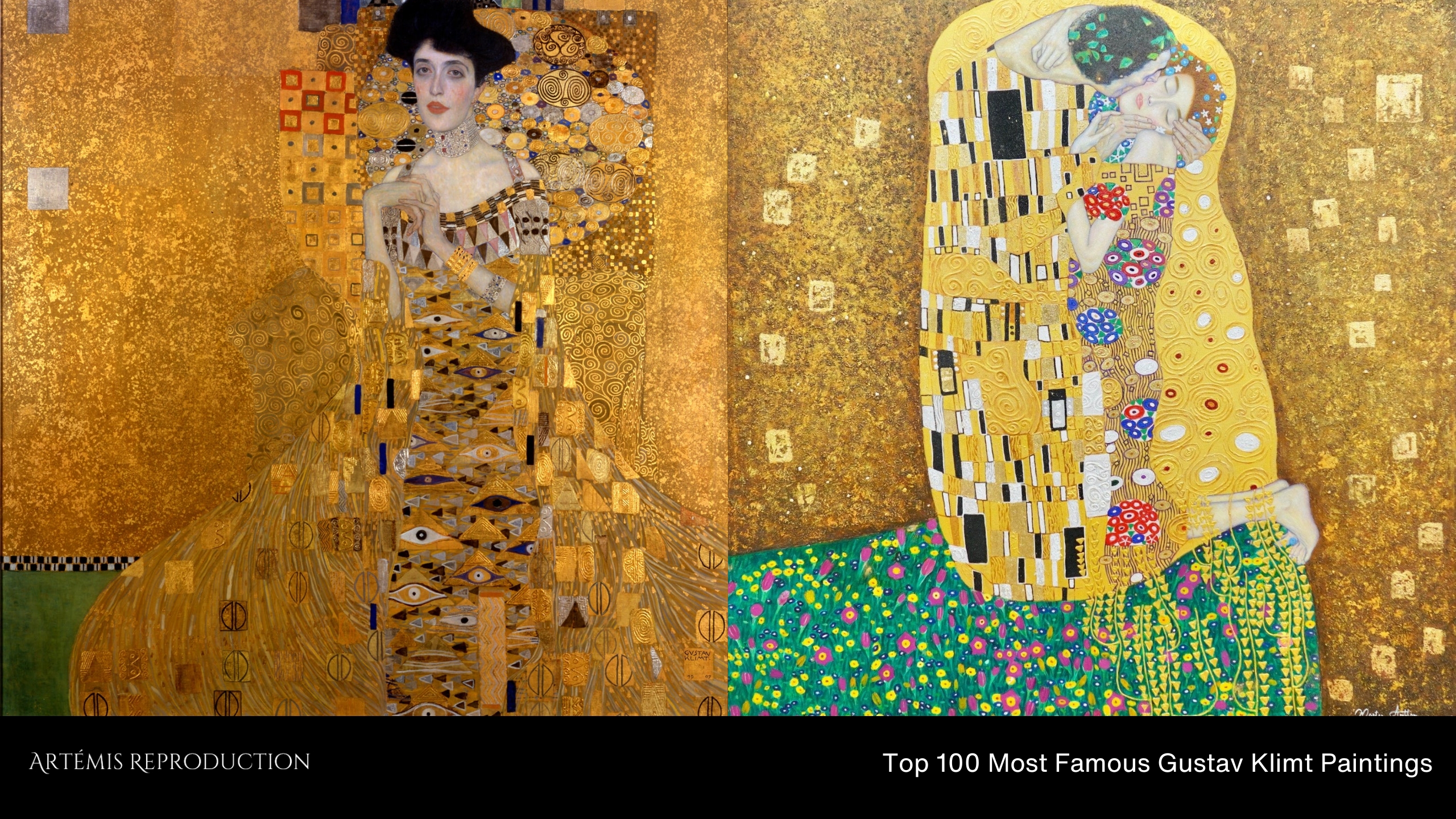
Explore the 100 Most Famous Gustav Klimt Paintings, one of the most renowned artists of the 20th century. In this curated list of the top 100 most famous paintings, we delve into the captivating world of Klimt’s golden era, intricate patterns, and symbolic imagery. From his celebrated masterpieces like The Kiss to lesser-known gems, this collection offers a comprehensive look at the iconic works that defined Klimt’s unique style and lasting legacy in the art world. Prepare to be mesmerized by the elegance, emotion, and depth of Klimt’s artistic genius.

1- Portrait of Margarethe Stonborough-Wittgenstein
Portrait of Margarethe Stonborough-Wittgenstein by Gustav Klimt is a striking 1905 painting that captures the elegance and intellect of Margarethe, a member of the prominent Wittgenstein family. Painted in Klimt’s distinctive style, the portrait highlights Margarethe’s poised demeanor and aristocratic grace, with meticulous attention to detail in the fabric of her dress and the subtle expression on her face.
Klimt skillfully merges realism with his signature decorative elements, creating a balance between the subject’s individuality and the artist’s artistic flair. The portrait exudes sophistication, reflecting Margarethe’s status in Viennese high society while also embodying the psychological depth Klimt often infused into his portraits. Through the delicate interplay of light and shadow, Klimt brings to life a timeless image of refined beauty and intelligence.

2- Portrait of Mada Primavesi
Portrait of Mada Primavesi by Gustav Klimt, completed in 1912, is a vibrant depiction of a young girl from a wealthy Viennese family. Mada, the daughter of banker Otto Primavesi, is captured in a lively and youthful pose, surrounded by a richly patterned background that exemplifies Klimt’s decorative style. Unlike many of Klimt’s more formal portraits, this painting radiates energy and playfulness, reflecting Mada’s spirited personality.
Klimt’s use of bold colors and detailed patterns enhances the youthful charm of the portrait, while the artist’s characteristic attention to texture and fabric adds depth and richness to the scene. The painting stands out as a celebration of youth, life, and individuality, showcasing Klimt’s ability to infuse personal character into his work.

3- The Kiss
The Kiss by Gustav Klimt, painted between 1907 and 1908, is one of the most iconic works in art history. This masterpiece is a celebration of love, intimacy, and connection, depicting a couple wrapped in an embrace, their bodies adorned in intricate gold patterns. Klimt’s use of gold leaf, a hallmark of his “Golden Phase,” creates a luminous effect, elevating the painting to an almost ethereal level.
The composition balances tenderness and sensuality, with the figures blending into the opulent background, symbolizing unity and timeless passion. The contrast between the flowing, organic shapes and the geometric patterns adds a unique visual tension, making The Kiss not just a depiction of a romantic moment but a profound statement on the power of love.

4- The Island on Lake Attersee
The Island on Lake Attersee by Gustav Klimt, painted in 1901, captures a serene and picturesque view of the Austrian lake’s tranquil beauty. This landscape showcases Klimt’s skillful use of color and light to depict the natural splendor of the setting. The painting features a small island amidst the expansive waters of Lake Attersee, with rolling hills and lush greenery in the background.
Klimt’s attention to detail and his ability to evoke a sense of calm and stillness through his brushwork are evident in this work. The composition reflects his admiration for nature and the Austrian countryside, offering a contrast to his more elaborate, ornate portraits. The peaceful scene invites viewers to experience the quiet elegance and natural harmony that Klimt masterfully conveys through his art.

5- The Golden Knight
The Golden Knight by Gustav Klimt, painted in 1903, is a compelling work that blends fantasy and symbolism with Klimt’s distinctive decorative style. The painting depicts a majestic knight adorned in a suit of shimmering gold armor, set against a richly textured background that emphasizes the figure’s grandeur.
Klimt’s use of gold leaf and intricate patterns enhances the knight’s regal appearance, creating a striking contrast with the dark, muted tones of the background. The composition merges elements of medieval and mythological themes, reflecting Klimt’s fascination with historical and allegorical subjects. Through his meticulous attention to detail and innovative use of materials, Klimt captures the essence of heroism and chivalry, infusing the figure with both a sense of historical weight and a timeless allure.

6- The Fur of the Polecat (Unfinished)
The Fur of the Polecat (Unfinished) by Gustav Klimt, painted around 1899, is an intriguing and incomplete work that showcases Klimt’s early experimentation with texture and pattern. The painting features a figure draped in a luxurious fur, with intricate details that hint at Klimt’s burgeoning interest in decorative elements and rich textures.
Though left unfinished, the piece offers insight into Klimt’s evolving style and his focus on the tactile quality of materials. The detailed depiction of the fur contrasts with the abstract, less defined background, highlighting Klimt’s innovative approach to blending realism with ornamental design. This work serves as a testament to Klimt’s artistic journey, capturing the transition from his early realism to his later, more iconic decorative works.

7- The Fulfillment
The Fulfillment by Gustav Klimt, painted in 1899, is a captivating work that reflects Klimt’s exploration of allegorical and symbolic themes. The painting is part of Klimt’s series of decorative works and showcases his fascination with the cycle of life and the concept of spiritual and physical fulfillment.
In this piece, Klimt uses rich, ornamental patterns and vibrant colors to depict a woman surrounded by symbolic elements. The composition is characterized by its intricate detail and the harmonious interplay of form and color, capturing a sense of transcendence and completion. The work exemplifies Klimt’s ability to blend narrative depth with his signature decorative style, creating a visually stunning representation of the themes of satisfaction and wholeness.

8- Portrait of Fritza Riedler
Portrait of Fritza Riedler by Gustav Klimt, painted in 1906, is a sophisticated and elegant depiction of Fritza Riedler, a prominent Viennese socialite. This portrait highlights Klimt’s mastery of combining realism with decorative elements, showcasing the sitter’s refined grace and poise.
In the painting, Riedler is presented in a regal pose, adorned in a luxurious, patterned gown that reflects Klimt’s signature use of rich textures and intricate details. The background features a harmonious blend of patterns and colors, creating a sense of depth and complexity that contrasts beautifully with the more subdued tones of the figure.
Klimt’s attention to detail in the depiction of Riedler’s attire and the subtle expression on her face captures her sophistication and the aura of high society. The portrait is a testament to Klimt’s ability to infuse personal character into his subjects while maintaining his distinctive decorative style.

9- Portrait of Friederike Maria Beer
Portrait of Friederike Maria Beer by Gustav Klimt, painted in 1916, is an elegant and emotive portrayal of Friederike Maria Beer, a prominent Viennese socialite. This painting exemplifies Klimt’s distinctive style, blending realism with his signature decorative elements.
In the portrait, Beer is depicted with a serene and introspective expression, dressed in a sophisticated gown adorned with intricate patterns and textures. The background features a richly patterned design that complements the figure and highlights Klimt’s masterful use of color and form.
Klimt’s attention to detail and the subtle interplay of light and shadow create a sense of depth and intimacy, capturing the essence of Beer’s personality while showcasing the artist’s innovative approach to portraiture. The painting is a testament to Klimt’s ability to combine personal elegance with his unique decorative style.

10- Portrait of Emilie Flöge II
Portrait of Emilie Flöge II by Gustav Klimt, painted in 1902, is a notable work that reflects the artist’s deep personal and professional relationship with Emilie Flöge, his long-time companion and muse. This portrait showcases Klimt’s distinctive style, blending detailed realism with ornate, decorative elements.
In the painting, Flöge is portrayed in a graceful and poised manner, wearing a richly patterned dress that exemplifies Klimt’s fascination with texture and design. The background is adorned with intricate patterns and gold accents, characteristic of Klimt’s “Golden Phase,” which adds a luxurious and ethereal quality to the composition.
Klimt’s careful attention to the interplay of patterns and colors enhances Flöge’s refined elegance while reflecting the artist’s unique approach to portraiture. The portrait is not only a testament to Klimt’s skillful use of decorative elements but also a poignant representation of his deep connection with Flöge.

11- The Friends
The Friends by Gustav Klimt, painted in 1903, is an evocative work that reflects Klimt’s early explorations into themes of companionship and social dynamics. The painting features a group of women in an intimate and relaxed setting, capturing a moment of connection and camaraderie.
Klimt’s use of soft colors and detailed patterns highlights the individuality of each figure while maintaining a harmonious overall composition. The interplay of textures and the careful attention to the patterns in the women’s clothing and the background contribute to the painting’s rich, decorative quality.
The work is notable for its portrayal of female friendships and its ability to convey a sense of warmth and closeness. Through his distinctive style and symbolic use of patterns, Klimt creates a visually captivating and emotionally resonant depiction of friendship.

12- The Family Embrace
The Family Embrace by Gustav Klimt, painted in 1912, is a poignant and intimate portrayal that reflects the artist’s interest in themes of familial bonds and affection. The painting depicts a family group enveloped in a warm and affectionate embrace, showcasing Klimt’s talent for capturing emotional depth through his art.
In this work, Klimt employs his signature decorative style, using intricate patterns and rich colors to create a visually stunning background that contrasts with the tender portrayal of the family members. The figures are intertwined in a loving and protective manner, emphasizing the closeness and unity within the family.
Klimt’s attention to detail and his ability to blend realism with ornate design elements make The Family Embrace a powerful representation of love and connection. The painting not only highlights the artist’s skillful use of color and texture but also captures the universal emotions of familial warmth and solidarity.
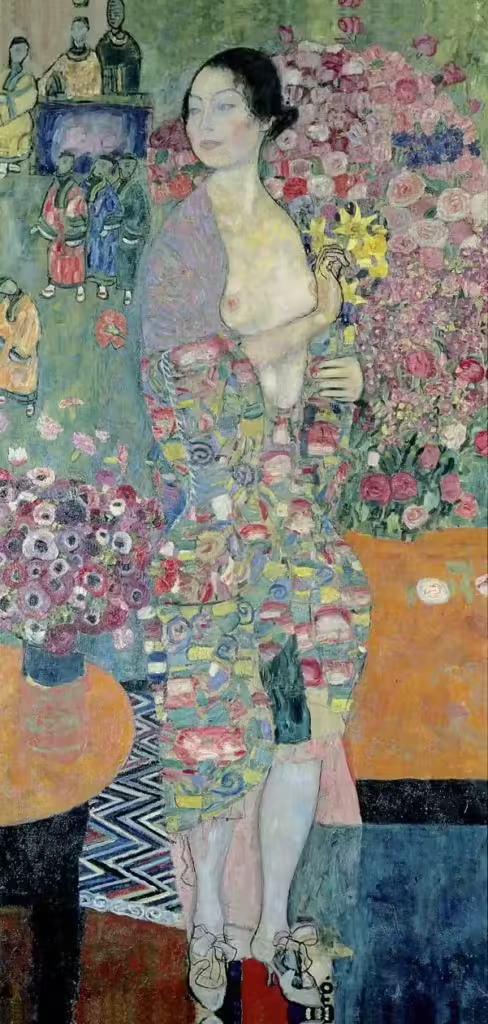
13- The Dancer
The Dancer by Gustav Klimt, painted around 1917, is a vibrant and dynamic work that reflects Klimt’s fascination with movement and grace. The painting captures the elegance and fluidity of dance, with a focus on the rhythmic motion of the dancer’s body.
In this piece, Klimt employs bold colors and intricate patterns to highlight the dancer’s expressive movements and the texture of her costume. The background features a blend of abstract and decorative elements, adding depth and enhancing the sense of motion.
Klimt’s use of gold and intricate design details reflects his signature style, while the composition conveys the energy and beauty of the dance. The painting is a testament to Klimt’s ability to merge artistic decoration with a profound appreciation for the human form and movement.

14- The Church of St. Wolfgang
The Church of St. Wolfgang by Gustav Klimt, painted in 1913, is a captivating landscape that showcases Klimt’s unique approach to architectural and natural subjects. This painting features the picturesque church of St. Wolfgang, situated on the shores of Lake Wolfgang in Austria, and is rendered in Klimt’s distinctive style.
The painting is characterized by its intricate details and bold color palette, capturing the serene beauty of the church and its surroundings. Klimt’s use of decorative elements and textured brushstrokes enhances the visual depth and richness of the scene, blending realism with his signature ornamental approach.
Klimt’s depiction of the church reflects his admiration for the natural landscape and his ability to convey a sense of tranquility and harmony. The work stands out for its combination of detailed architectural representation and abstract decorative patterns, illustrating Klimt’s versatility as an artist.
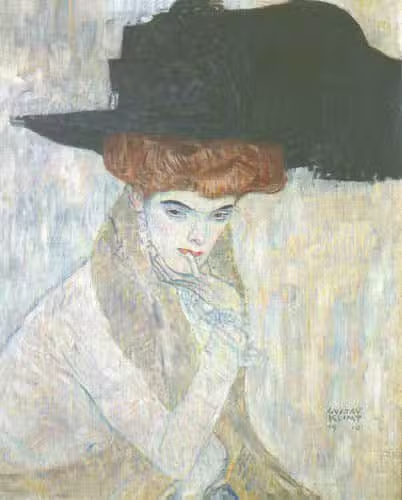
15- The Black Feather Hat
The Black Feather Hat by Gustav Klimt, painted in 1910, is a striking portrait that showcases Klimt’s distinctive style and his fascination with elaborate fashion and ornamental detail. The painting features a woman wearing an extravagant black feather hat, which serves as the focal point of the composition.
Klimt’s use of rich textures and intricate patterns highlights the hat’s dramatic and luxurious appearance, while the background is adorned with abstract, decorative elements that complement the central figure. The artist’s attention to detail and his skillful use of color and light create a vivid contrast between the ornate hat and the more subdued tones of the woman’s attire.
The portrait reflects Klimt’s interest in exploring themes of beauty and elegance through fashion, while also demonstrating his ability to blend realism with ornamental design. The Black Feather Hat exemplifies Klimt’s unique approach to portraiture, capturing both the individual character of the sitter and the opulence of the accessory.

16- Tears of Gold
Tears of Gold by Gustav Klimt, painted around 1909, is a poignant and emotive work that reflects Klimt’s interest in themes of sorrow and beauty. The painting features a central figure, often interpreted as a woman, with tears rendered in striking golden tones that contrast with the darker background.
Klimt’s use of gold leaf and intricate patterns adds a rich, textured quality to the painting, emphasizing the emotional depth and intensity of the subject’s expression. The golden tears symbolize a sense of profound sadness or loss, while the decorative elements enhance the overall visual impact of the composition.
The painting is notable for its combination of symbolic content and Klimt’s distinctive decorative style, capturing the interplay between beauty and melancholy. Tears of Gold exemplifies Klimt’s ability to convey complex emotions through his unique approach to color, texture, and symbolism.

17- The Ancient Theater of Taormina
The Ancient Theater of Taormina by Gustav Klimt, painted in 1899, is a captivating depiction of the historic Roman amphitheater located in Taormina, Sicily. This work reflects Klimt’s early interest in architectural subjects and his evolving artistic style.
The painting portrays the grandeur and historical significance of the ancient theater, with Klimt’s attention to detail capturing the structure’s architectural elements and the surrounding landscape. The composition is characterized by its meticulous rendering of the theater’s ruins and the dramatic interplay of light and shadow.
Klimt’s use of color and texture in this piece demonstrates his ability to merge realistic depiction with his emerging decorative sensibilities. The Ancient Theater of Taormina is a testament to Klimt’s skill in combining historical and architectural themes with his developing artistic vision.
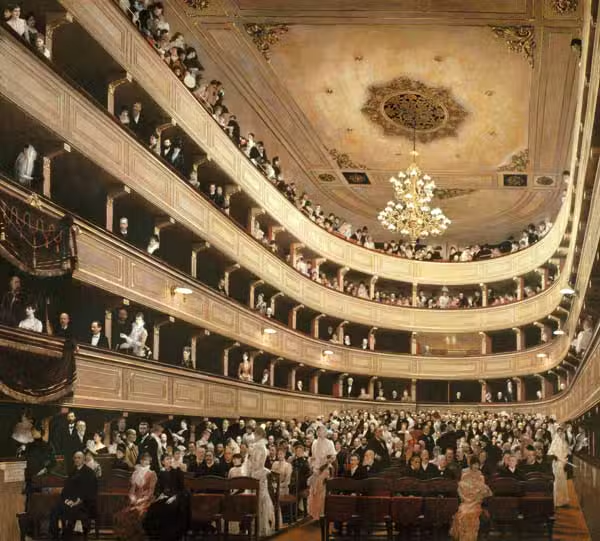
18- The Auditorium of the Old Castle Theater
The Auditorium of the Old Castle Theater by Gustav Klimt, painted around 1898, is a fascinating representation of the interior of a historic theater. This work captures the grandeur and architectural beauty of the old castle theater’s auditorium, showcasing Klimt’s early focus on architectural subjects.
The painting features a detailed depiction of the theater’s seating and ornate decorations, reflecting Klimt’s meticulous attention to architectural detail. The composition highlights the intricate patterns and textures of the interior, blending realism with Klimt’s emerging decorative style.
Klimt’s use of color and light enhances the atmosphere of the theater, creating a sense of depth and historical ambiance. The Auditorium of the Old Castle Theater exemplifies Klimt’s ability to merge architectural precision with artistic expression, capturing the elegance and historical significance of the theater’s design.

19- Old Woman
Old Woman by Gustav Klimt, painted in 1899, is a poignant and introspective work that delves into themes of aging and mortality. The painting features an elderly woman depicted with a raw and unflinching honesty, reflecting Klimt’s exploration of human vulnerability.
In this portrait, Klimt uses a muted color palette and detailed brushwork to convey the weariness and character of the subject. The woman’s expression and posture are rendered with a sense of gravity and empathy, capturing the physical and emotional aspects of old age.
Klimt’s attention to texture and form in this work highlights his ability to infuse realism with emotional depth, while his use of color and composition adds to the painting’s overall impact. Old Woman stands out as a reflective and compassionate portrayal of the later stages of life, showcasing Klimt’s capacity to convey profound themes through his art.

20- Mother and Twins – Gustav Klimt Oil Painting Reproduction
Mother and Twins by Gustav Klimt is a poignant and evocative work that captures the tender bond between a mother and her children. Painted in 1905, this artwork exemplifies Klimt’s ability to blend realism with his distinctive decorative style.
In this reproduction, the mother is depicted with her twin children, enveloped in a warm and intimate embrace. Klimt’s use of soft colors and intricate patterns creates a sense of harmony and affection, while the detailed rendering of the figures highlights the emotional depth of the scene.
The oil painting reproduction maintains the essence of Klimt’s original work, preserving the delicate interplay of light and texture. The painting reflects the artist’s exploration of themes related to family and connection, making it a timeless representation of maternal love and tenderness.

21- Malcesine on Lake Garda – Gustav Klimt Oil Painting Reproduction
Malcesine on Lake Garda by Gustav Klimt is a serene and captivating landscape painting completed in 1913. This reproduction captures the tranquil beauty of the picturesque town of Malcesine, situated on the shores of Lake Garda in Italy.
In this oil painting, Klimt’s attention to detail and use of vibrant colors bring the scenic landscape to life. The composition features the charming architecture of Malcesine, set against the backdrop of the lake and rolling hills. Klimt’s distinctive brushwork and use of color create a sense of depth and tranquility, highlighting the natural beauty of the area.
The oil painting reproduction faithfully preserves the essence of Klimt’s original work, reflecting his ability to blend realistic depiction with his unique decorative style. This piece stands as a testament to Klimt’s appreciation for the scenic landscapes of Italy and his skill in capturing their beauty on canvas.

22- Portrait of a Lady (Mrs. Heymann) – Gustav Klimt
Portrait of a Lady (Mrs. Heymann) by Gustav Klimt, painted in 1917-1918, is an elegant and intimate representation of Mrs. Heymann, a prominent Viennese socialite. This portrait reflects Klimt’s refined approach to capturing his subjects, combining his distinctive decorative style with a deep psychological insight.
In the painting, Mrs. Heymann is depicted with a poised and graceful demeanor, adorned in a beautifully detailed gown that highlights Klimt’s mastery of texture and pattern. The background features intricate, ornamental elements that complement the figure and enhance the overall composition.
Klimt’s use of color, light, and pattern creates a sophisticated contrast between the figure and her surroundings, emphasizing the subject’s elegance and social status. Portrait of a Lady (Mrs. Heymann) exemplifies Klimt’s ability to blend realism with decorative art, capturing both the personal character of his subject and his unique artistic vision.

23- Portrait of a Lady with a Violet Scarf – Gustav Klimt
Portrait of a Lady with a Violet Scarf by Gustav Klimt, painted in 1917, is a refined and captivating portrait that showcases Klimt’s signature style and his attention to detail. The painting features a sophisticated lady adorned in a striking violet scarf, which serves as a central element in the composition.
In this portrait, Klimt uses rich, vibrant colors and intricate patterns to highlight the elegance of the scarf and the grace of the lady. The background is adorned with decorative elements that complement the subject, creating a harmonious balance between the figure and the ornamental design.
Klimt’s use of light and texture enhances the depth and richness of the portrait, capturing both the beauty of the fabric and the refined demeanor of the subject. Portrait of a Lady with a Violet Scarf exemplifies Klimt’s ability to blend realism with his distinctive decorative style, resulting in a visually stunning and emotionally evocative work.

24- Orchard with Roses – Gustav Klimt
Orchard with Roses by Gustav Klimt, painted in 1905, is a vivid and enchanting landscape that captures the beauty of nature through Klimt’s distinctive style. This painting features a lush orchard filled with blooming roses, creating a vibrant and harmonious scene.
In Orchard with Roses, Klimt’s use of color and pattern brings the natural landscape to life, highlighting the intricate details of the flowers and foliage. The composition is characterized by its rich textures and bold colors, which create a sense of depth and movement within the painting.
Klimt’s signature ornamental elements are evident in the depiction of the roses and the surrounding vegetation, blending realism with decorative artistry. The painting reflects Klimt’s appreciation for the beauty of nature and his ability to infuse it with a sense of elegance and intricacy.

25- Kiss, Detail of The Beethoven Frieze – Gustav Klimt
Kiss, a detail from The Beethoven Frieze by Gustav Klimt, is a compelling and intimate segment of the larger mural created in 1902. This section of the frieze captures the essence of romantic and symbolic expression that Klimt masterfully employed throughout the work.
In this detail, Klimt focuses on the central motif of the kiss, highlighting the tenderness and emotional depth of the moment. The use of gold leaf and intricate patterns emphasizes the opulence and beauty of the figures, with Klimt’s signature style blending realism with decorative elements.
The background of the frieze features Klimt’s distinctive ornamental patterns and textures, which complement the intimate and passionate embrace of the figures. This detail exemplifies Klimt’s ability to convey profound themes of love and connection through his innovative use of color, form, and symbolism.

26- Jurisprudence – Gustav Klimt
Jurisprudence by Gustav Klimt, painted in 1903, is a profound and symbolic work that reflects Klimt’s exploration of themes related to law and justice. This painting is part of Klimt’s series of allegorical works, which often delve into philosophical and societal themes.
In Jurisprudence, Klimt portrays a complex composition featuring symbolic figures and allegorical elements that represent the concept of justice. The painting includes a central figure surrounded by various representations of legal and moral themes, rendered with Klimt’s characteristic use of vibrant colors and intricate patterns.
The work is notable for its rich, detailed patterns and the use of symbolic imagery to convey the weight and complexity of jurisprudence. Klimt’s ability to blend decorative elements with profound thematic content is evident, making Jurisprudence a powerful reflection on the nature of law and justice.

27- Judith II – Gustav Klimt
Judith II (also known as Judith and the Head of Holofernes) by Gustav Klimt, painted in 1909, is a striking and dramatic portrayal of the biblical figure Judith. This painting is part of Klimt’s exploration of powerful female figures and is known for its bold use of color and intricate patterns.
In Judith II, Klimt presents Judith in a moment of triumph, holding the severed head of Holofernes with a confident and alluring gaze. The use of rich, gold tones and elaborate decorative elements highlights Judith’s strength and beauty, while the intricate background patterns enhance the sense of opulence and intensity.
Klimt’s painting combines elements of symbolism and sensuality, capturing both the dramatic narrative and the psychological depth of the character. The work exemplifies Klimt’s ability to merge narrative content with his distinctive ornamental style, creating a powerful and visually captivating depiction.
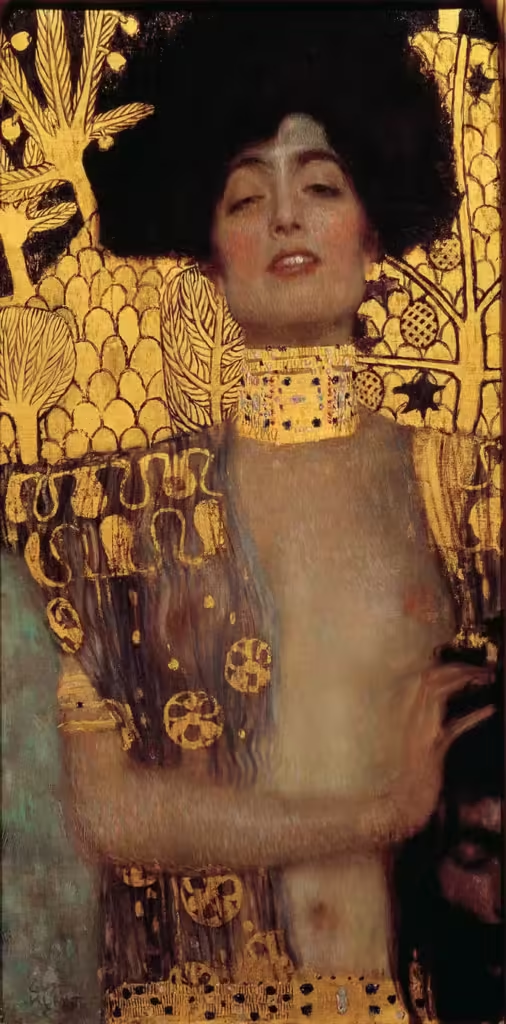
28- Judith with the Head of Holofernes – Gustav Klimt
Judith with the Head of Holofernes by Gustav Klimt, painted in 1901, is a dramatic and compelling depiction of the biblical heroine Judith. This painting captures the moment of triumph and vengeance as Judith holds the severed head of the Assyrian general Holofernes.
In this work, Klimt’s use of vibrant colors and gold leaf creates a striking contrast between the figure of Judith and the dark, detailed background. Judith is portrayed with a mix of sensuality and strength, her expression both confident and intense as she presents the head. The intricate patterns and ornate details surrounding her enhance the painting’s dramatic and opulent quality.
Klimt’s approach to the subject blends narrative and symbolism with his signature decorative style, resulting in a powerful and visually captivating representation of this iconic biblical story.
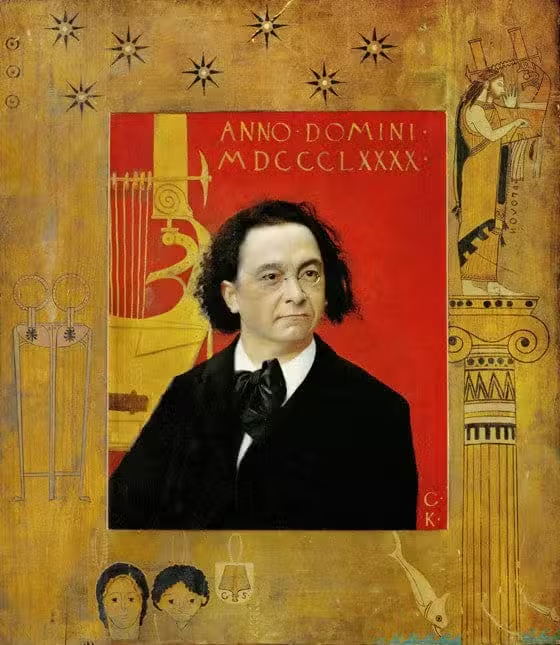
29- Portrait of Joseph Pembaur, the Pianist and Composer – Gustav Klimt
Portrait of Joseph Pembaur, the Pianist and Composer by Gustav Klimt, painted in 1899, is a distinguished portrayal of the Austrian pianist and composer. This portrait captures Pembaur with an air of sophistication and introspection, reflecting Klimt’s early explorations into portraiture and his attention to detail.
In the painting, Pembaur is depicted with a thoughtful expression, dressed in formal attire that underscores his status and professional demeanor. Klimt’s use of color and texture highlights the subject’s dignified presence while maintaining a balance with the elegant background elements.
Klimt’s detailed brushwork and careful rendering of Pembaur’s features reveal his commitment to capturing the essence of his subject. The portrait is a testament to Klimt’s skill in blending realism with his emerging decorative style, creating a refined and memorable image of the esteemed pianist and composer.

30- Portrait of Gertha Felssovanyi – Gustav Klimt
Portrait of Gertha Felssovanyi by Gustav Klimt, painted in 1902, is a refined and elegant representation of Gertha Felssovanyi, a prominent Viennese socialite. This portrait exemplifies Klimt’s ability to blend realism with his distinctive decorative style.
In the painting, Felssovanyi is depicted with grace and sophistication, adorned in a detailed gown that reflects Klimt’s interest in fashion and texture. The background features intricate patterns and subtle colors that complement the figure, creating a harmonious and visually striking composition.
Klimt’s use of rich textures and his attention to the delicate details of Felssovanyi’s attire and expression showcase his skill in capturing the personality and elegance of his subjects. Portrait of Gertha Felssovanyi stands as a testament to Klimt’s artistry and his ability to convey both personal character and stylistic flair.

31- Philosophy (Final State) – Gustav Klimt
Philosophy (Final State) by Gustav Klimt, painted between 1907 and 1908, is a significant work that reflects Klimt’s engagement with allegorical and philosophical themes. This painting represents the culmination of Klimt’s exploration of philosophical ideas and his innovative approach to decorative art.
In Philosophy, Klimt portrays a complex, multi-layered composition featuring allegorical figures and symbols that represent various aspects of human thought and knowledge. The painting includes a central figure surrounded by intricate patterns and ornamental elements that blend seamlessly with the philosophical themes being explored.
Klimt’s use of color, texture, and pattern in this work is characteristic of his signature style, combining detailed realism with rich, decorative elements. The painting is notable for its elaborate and symbolic representation of philosophical concepts, showcasing Klimt’s ability to merge intellectual content with his unique artistic vision.

32- Danaë 1907 – Gustav Klimt
Danaë (1907) by Gustav Klimt is a captivating and sensual portrayal of the ancient Greek mythological figure Danaë. This painting is one of Klimt’s masterpieces, showcasing his distinctive style and his fascination with themes of eroticism and myth.
In Danaë, Klimt depicts the mythological princess enveloped in a cascade of golden rain, symbolizing the god Zeus’s divine intervention. The use of gold leaf and rich textures enhances the opulence and sensuality of the scene, while the intricate patterns and luminous colors create a striking contrast with Danaë’s delicate form.
The painting captures Danaë’s expression of both vulnerability and ecstatic anticipation, reflecting Klimt’s skill in blending symbolic content with his characteristic ornamental style. Danaë 1907 exemplifies Klimt’s ability to infuse classical themes with modern artistic sensibilities, resulting in a visually stunning and emotionally evocative work.

33- The Young Girl with the Blue Veil – Gustav Klimt
The Young Girl with the Blue Veil by Gustav Klimt, painted in 1917, is a charming and elegant portrait that captures the innocence and grace of the young subject. This painting reflects Klimt’s interest in blending portraiture with his distinctive decorative style.
In this work, Klimt portrays the young girl with a delicate blue veil draped around her shoulders, which adds a touch of ethereal beauty to the composition. The background features intricate patterns and ornamental details, characteristic of Klimt’s signature style, which enhance the overall visual richness of the portrait.
Klimt’s use of color and texture creates a sense of depth and refinement, highlighting the girl’s serene expression and the flowing lines of her attire. The Young Girl with the Blue Veil exemplifies Klimt’s ability to combine realistic portrayal with decorative elements, resulting in a captivating and elegant representation of youthful grace.
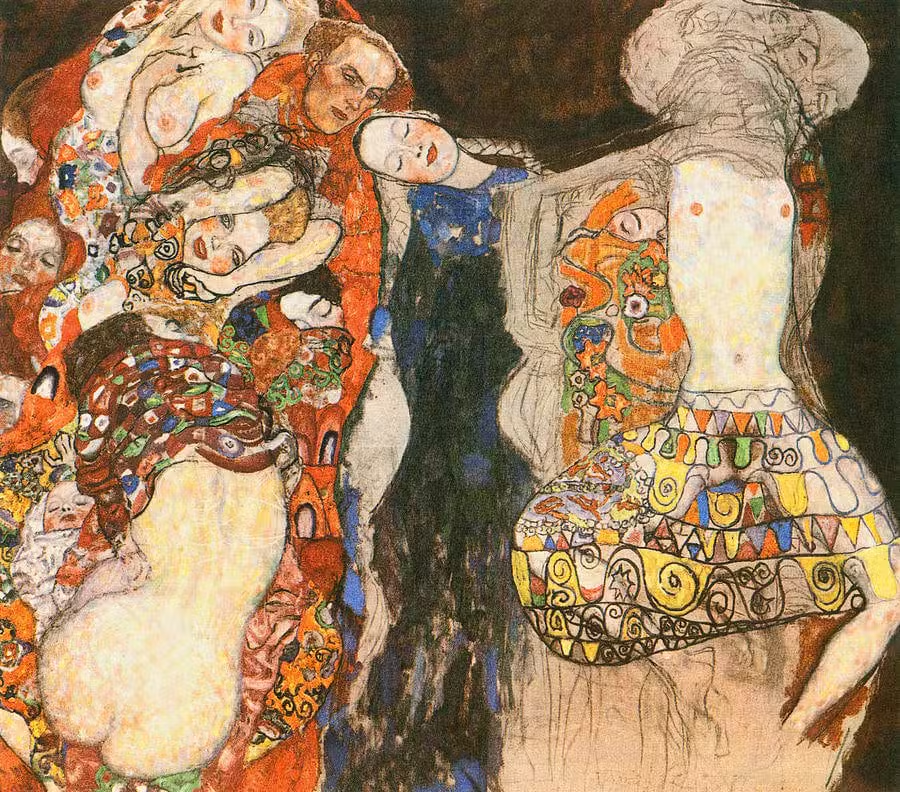
34- The Unfinished Bride – Gustav Klimt
The Unfinished Bride by Gustav Klimt, painted in 1917-1918, is a poignant and intriguing work that captures the essence of Klimt’s distinctive style while showcasing a more somber and introspective theme. The painting remains unfinished, adding a layer of mystery and contemplation to its composition.
In The Unfinished Bride, Klimt portrays a bride in an elegant yet unfinished state, draped in flowing fabric and adorned with intricate patterns. The use of gold leaf and detailed textures highlights the bride’s presence and the opulence of her attire, while the unfinished aspects of the painting suggest an incomplete narrative or an interrupted moment.
Klimt’s approach to the subject combines realistic detail with his signature decorative elements, creating a striking contrast between the richly adorned figure and the unfinished areas of the canvas. The Unfinished Bride reflects Klimt’s ability to evoke a sense of melancholy and reflection, blending beauty with the sense of an unfulfilled story.

35- The Tree of Life, Central Section (Detail) – Gustav Klimt
The Tree of Life, Central Section (Detail) by Gustav Klimt, painted in 1909, is a mesmerizing detail from one of Klimt’s most iconic works. This section captures the intricate beauty and symbolic depth of the larger mural, showcasing Klimt’s distinctive use of gold and ornamental design.
In this detail, the central focus is on the elegant, spiraling branches of the tree, adorned with intricate patterns and golden accents. The swirling forms and decorative elements are characteristic of Klimt’s style, creating a sense of movement and continuity within the composition.
The use of gold leaf and intricate detailing in this section highlights Klimt’s mastery of decorative art and his ability to infuse symbolic meaning into his work. The Tree of Life represents themes of growth, renewal, and interconnectedness, and this detail exemplifies Klimt’s talent for blending symbolism with his unique artistic vision.

36- The Three Ages of Woman – Gustav Klimt
The Three Ages of Woman by Gustav Klimt, painted in 1905, is a profound and evocative work that explores the stages of a woman’s life. This painting reflects Klimt’s interest in themes of life, growth, and the passage of time, rendered with his signature decorative style.
In this piece, Klimt presents a triptych composition that depicts three phases of a woman’s life: youth, adulthood, and old age. The central figure of the young woman, surrounded by a radiant and floral motif, contrasts with the mature woman and the elderly figure, who are depicted with more subdued and intricate patterns.
The painting’s use of rich colors, gold leaf, and intricate detailing enhances the emotional depth and symbolic significance of each stage of life. Klimt’s ability to blend realism with ornamental elements creates a striking and thought-provoking representation of the human experience. The Three Ages of Woman exemplifies Klimt’s talent for combining narrative content with his distinctive artistic vision.
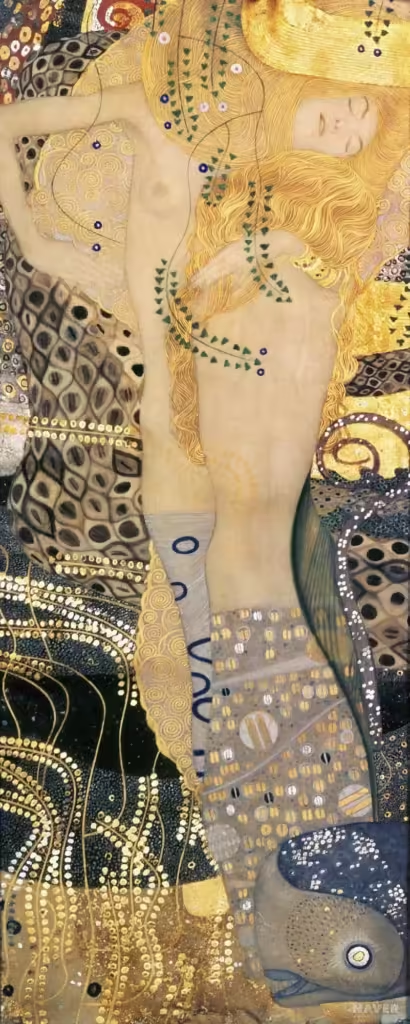
37- Water Serpent II – Gustav Klimt
Water Serpent II by Gustav Klimt, painted in 1904-1907, is a striking work that delves into the themes of sensuality and mythology. This painting is known for its intricate details and the use of symbolism, showcasing Klimt’s signature style and his fascination with the female form.
In Water Serpent II, Klimt depicts a mythical water serpent or nymph entwined in a flowing, serpentine pose. The figure is adorned with elaborate patterns and vibrant colors that highlight the sensuality and grace of the subject. The background features Klimt’s characteristic decorative elements, including ornate patterns and textures that enhance the painting’s ethereal quality.
The painting’s use of gold leaf and rich textures creates a sense of opulence and depth, while the serpentine form of the central figure adds an element of mystery and allure. Water Serpent II exemplifies Klimt’s ability to blend symbolic content with his distinctive decorative style, resulting in a visually captivating and emotionally evocative work.

38- Water Serpents – Gustav Klimt
Water Serpents by Gustav Klimt, painted in 1904-1907, is a mesmerizing and sensual work that explores themes of mythology and the feminine form. This painting is renowned for its intricate detail and decorative style, characteristic of Klimt’s work during this period.
In Water Serpents, Klimt depicts a group of water nymphs or serpents in a lush, aquatic setting. The figures are rendered with flowing lines and elaborate patterns that emphasize their ethereal and otherworldly nature. The use of vibrant colors and gold leaf enhances the opulence and sensuality of the scene.
The painting’s background features intricate, ornamental details that complement the fluidity and grace of the serpents, creating a harmonious and visually captivating composition. Water Serpents reflects Klimt’s fascination with mythological themes and his ability to combine realism with his distinctive decorative style, resulting in a work that is both enchanting and evocative.
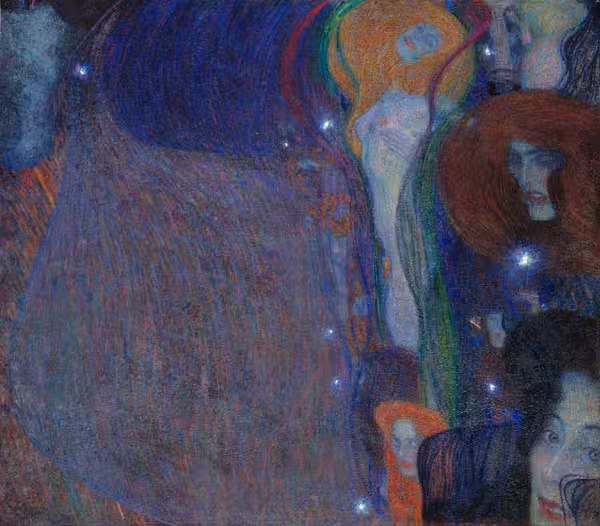
39- Will-o’-the-Wisps – Gustav Klimt
Will-o’-the-Wisps by Gustav Klimt, painted in 1901, is a haunting and evocative work that delves into the realms of mysticism and the supernatural. This painting is noted for its enigmatic subject matter and Klimt’s distinctive use of color and texture.
In Will-o’-the-Wisps, Klimt portrays ethereal, otherworldly figures known as will-o’-the-wisps—mystical lights that appear over marshes and bogs in folklore. The painting captures the elusive and enigmatic nature of these phenomena, with the figures depicted as ghostly, shimmering entities amidst a dark, atmospheric background.
Klimt’s use of color and light creates a sense of mystery and intrigue, while the intricate patterns and textures add depth and visual interest to the composition. The painting reflects Klimt’s fascination with the supernatural and his ability to infuse his works with a sense of otherworldly beauty and allure. Will-o’-the-Wisps exemplifies Klimt’s talent for blending symbolic themes with his unique artistic style.
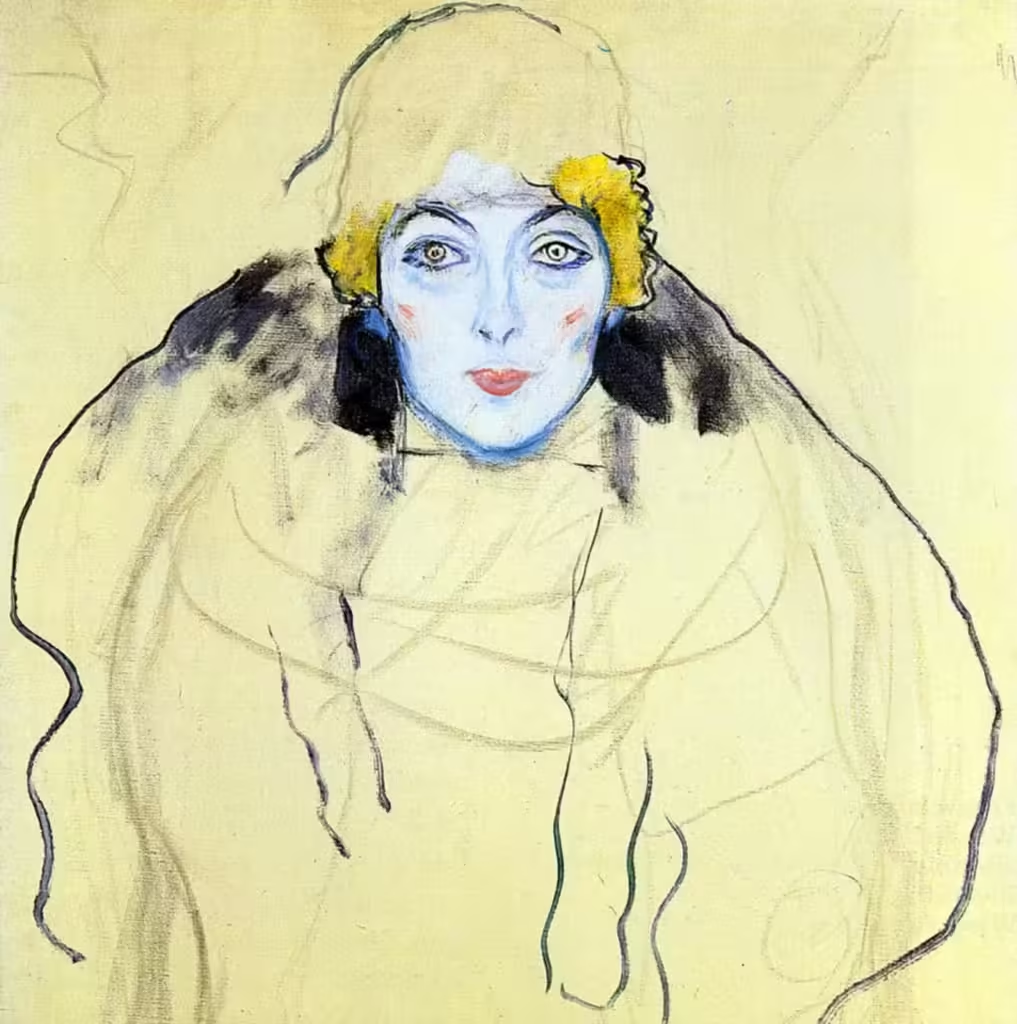
40- Woman’s Head 1917 – Gustav Klimt
Woman’s Head 1917 by Gustav Klimt is a striking and intimate portrait that reflects Klimt’s exploration of female beauty and expression during his later years. Painted in 1917, this work captures a moment of profound introspection and elegance.
In this portrait, Klimt presents a close-up view of a woman’s head, focusing on her expressive features and the delicate textures of her hair and attire. The use of subtle colors and intricate patterns highlights the refinement of the subject, while the composition emphasizes the emotional depth and introspective quality of the portrait.
Klimt’s distinctive style is evident in the detailed brushwork and ornamental elements that frame the figure, creating a sense of harmony between realism and decorative art. Woman’s Head 1917 exemplifies Klimt’s ability to convey both the inner character and outer beauty of his subjects, resulting in a captivating and evocative work.

41- Water in Motion – Gustav Klimt
Water in Motion by Gustav Klimt, painted in 1904, is a captivating exploration of the fluid and dynamic qualities of water. This work reflects Klimt’s fascination with natural elements and his skill in blending them with his distinctive decorative style.
In Water in Motion, Klimt depicts water in a series of flowing, undulating forms that convey a sense of movement and fluidity. The painting features intricate patterns and textures that mimic the natural movement of water, creating a harmonious and visually engaging composition.
Klimt’s use of color and light enhances the sense of fluidity and dynamism in the painting, while the detailed brushwork and ornamental elements add depth and complexity. Water in Motion exemplifies Klimt’s ability to merge natural themes with his unique artistic vision, resulting in a work that is both visually stunning and thematically evocative.
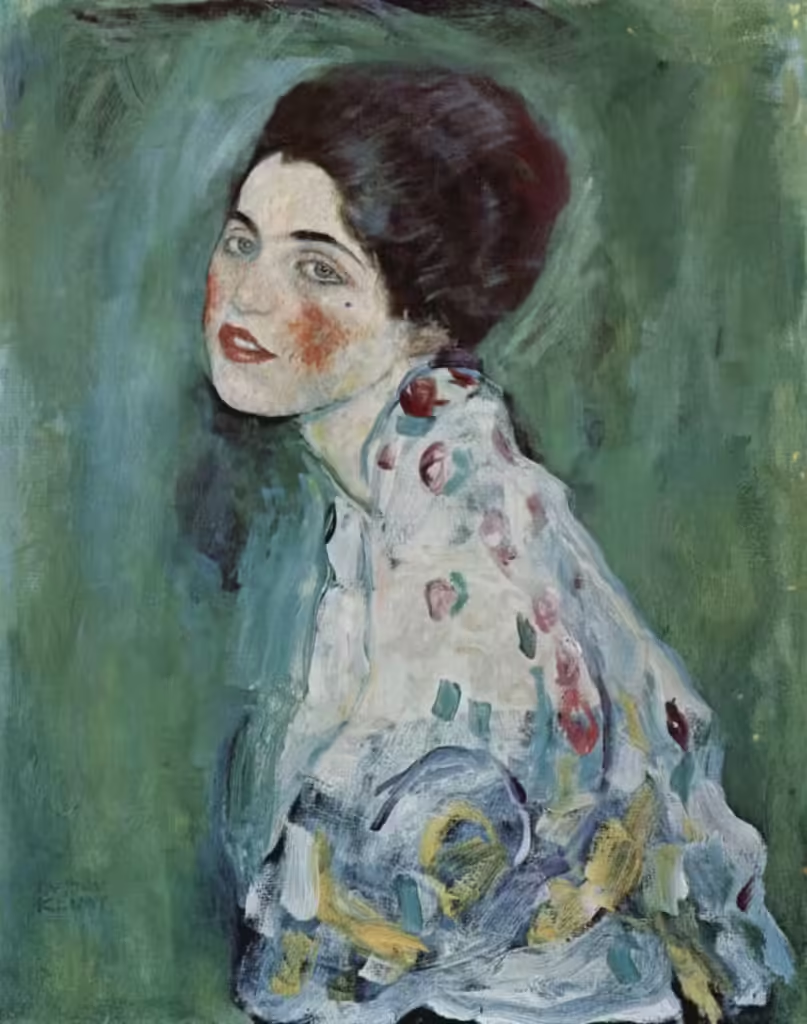
42- Portrait of a Lady – Gustav Klimt
Portrait of a Lady by Gustav Klimt, painted in 1912, is an exquisite and sophisticated representation of a Viennese woman. This portrait exemplifies Klimt’s mastery in capturing the elegance and personality of his subjects while showcasing his distinctive decorative style.
In this painting, the lady is depicted with a graceful and dignified presence, dressed in a richly detailed gown that reflects Klimt’s attention to texture and pattern. The background features intricate ornamental designs that complement the subject, enhancing the overall visual impact of the portrait.
Klimt’s use of color, light, and texture in Portrait of a Lady creates a sense of depth and refinement, highlighting the subject’s poise and sophistication. The combination of realistic portrayal and decorative elements exemplifies Klimt’s ability to merge narrative content with his unique artistic vision, resulting in a captivating and elegant work.

43- Portrait of Adele Bloch-Bauer I – Gustav Klimt
Portrait of Adele Bloch-Bauer I by Gustav Klimt, painted in 1907, is one of Klimt’s most celebrated masterpieces and a quintessential example of his distinctive style. This portrait is renowned for its opulence, intricate detail, and the iconic use of gold leaf.
In Portrait of Adele Bloch-Bauer I, Klimt depicts Adele Bloch-Bauer, a prominent Viennese socialite, in a lavish and elegant manner. The painting showcases Adele in a richly decorated gown with elaborate patterns, set against a background of shimmering gold. The use of gold leaf and intricate, ornamental designs creates a striking contrast with the portrait’s subject, emphasizing her sophistication and grandeur.
The composition reflects Klimt’s mastery in blending realistic detail with decorative elements, capturing both the personal elegance of Adele and the artistic opulence of the period. Portrait of Adele Bloch-Bauer I stands as a testament to Klimt’s ability to merge beauty, symbolism, and technical skill into a visually stunning and historically significant work.

44- Portrait of a Woman – Gustav Klimt
Portrait of a Woman by Gustav Klimt, painted in 1917-1918, is a compelling and refined work that reflects Klimt’s mature artistic style and his fascination with capturing the essence of his subjects.
In this portrait, the woman is depicted with a subtle yet captivating grace, her attire and the background adorned with Klimt’s signature intricate patterns and textures. The composition combines realistic portrayal with ornamental elements, creating a harmonious balance between the subject and the decorative aspects of the painting.
Klimt’s use of color, light, and detailed patterns enhances the elegance of the woman, highlighting her refined demeanor and the richness of the textures. Portrait of a Woman exemplifies Klimt’s ability to infuse his portraits with both personal character and aesthetic complexity, resulting in a visually stunning and emotionally evocative work.
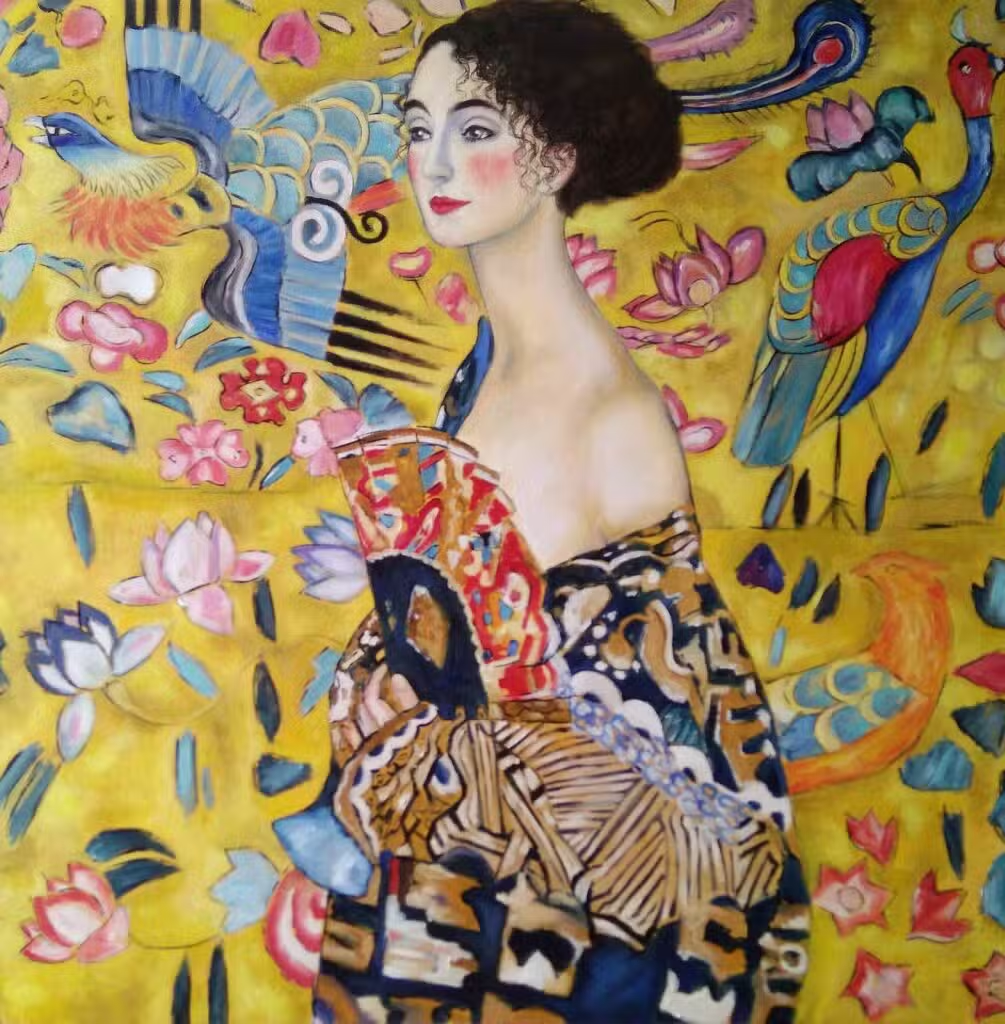
45- The Lady with the Fan – Gustav Klimt
The Lady with the Fan by Gustav Klimt, painted in 1917-1918, is a graceful and evocative portrait that showcases Klimt’s signature style and his fascination with the interplay of form and decoration.
In this painting, Klimt depicts a woman holding a fan, with her elegant pose and refined attire capturing the viewer’s attention. The fan, adorned with intricate patterns, serves as both a focal point and a complement to the richly detailed background. The use of delicate colors and Klimt’s characteristic gold and ornamental motifs create a sense of sophistication and allure.
The painting’s composition blends realism with decorative art, highlighting the woman’s graceful presence while integrating the fan and background into a cohesive and visually striking design. The Lady with the Fan exemplifies Klimt’s mastery in merging personal portraiture with his distinctive decorative style, resulting in a work that is both elegant and visually captivating.

46- Tree of Life at the Stoclet Villa – Gustav Klimt
Tree of Life at the Stoclet Villa by Gustav Klimt, created between 1905 and 1909, is a prominent and symbolic work that adorns the dining room of the Stoclet Palace in Brussels, designed by architect Josef Hoffmann. This mural is renowned for its intricate design and is one of Klimt’s most celebrated decorative pieces.
In this work, Klimt presents a majestic tree with spiraling branches and elaborate gold detailing. The Tree of Life is depicted in a style that merges symbolism with intricate patterns, creating a visually stunning representation of growth, renewal, and interconnectedness. The background and surrounding elements are adorned with Klimt’s signature ornamental motifs, enhancing the mural’s opulence and harmony.
The use of gold leaf and detailed patterns in Tree of Life at the Stoclet Villa exemplifies Klimt’s ability to blend artistic innovation with symbolic depth, resulting in a work that is both decorative and thematically rich. The mural remains a key example of Klimt’s influence on early 20th-century decorative art and architecture.
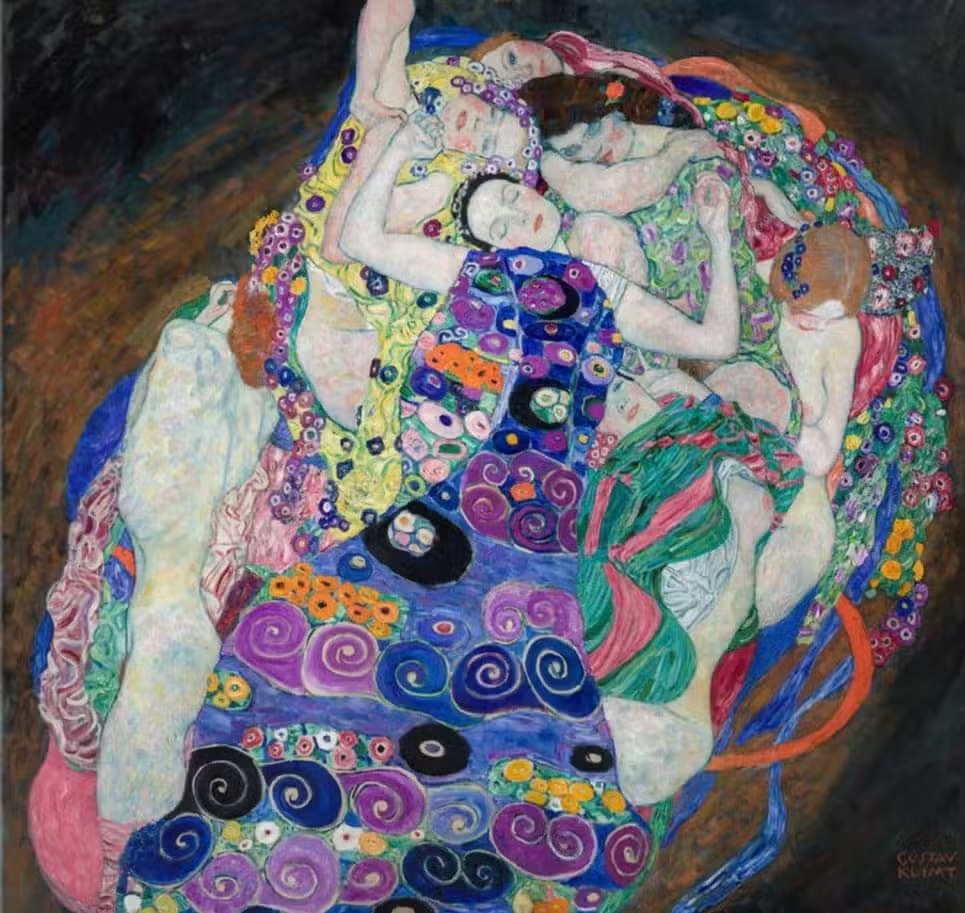
47- The Maiden – Gustav Klimt
The Maiden by Gustav Klimt, painted in 1913-1914, is a vibrant and evocative work that captures the ethereal beauty and grace of a young woman. This painting exemplifies Klimt’s mastery in blending decorative elements with symbolic content.
In The Maiden, Klimt depicts a young woman with a serene and contemplative expression, surrounded by a richly decorated background. The figure is adorned with intricate patterns and textures, which are characteristic of Klimt’s signature style. The use of color, light, and ornamental details creates a sense of depth and complexity, highlighting the woman’s elegance and youthful allure.
The painting’s composition merges realistic portrayal with abstract and decorative elements, reflecting Klimt’s ability to convey both personal beauty and artistic innovation. The Maiden stands as a testament to Klimt’s skill in capturing the essence of his subjects while integrating them into a visually stunning and thematically resonant work.
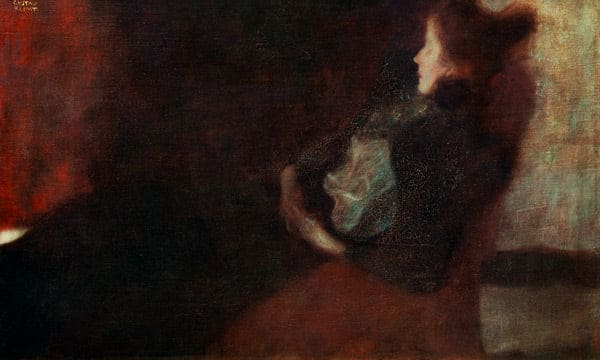
48- The Lady by the Fireplace – Gustav Klimt
The Lady by the Fireplace by Gustav Klimt, painted in 1916, is a striking and intimate portrait that captures the elegance and warmth of its subject. This work showcases Klimt’s talent for blending realistic portraiture with his distinctive decorative style.
In The Lady by the Fireplace, Klimt depicts a refined woman seated beside a fireplace, exuding a sense of comfort and sophistication. The painting features a rich, detailed background that enhances the overall warmth and opulence of the scene. The woman’s attire and the surrounding elements are rendered with intricate patterns and textures, characteristic of Klimt’s signature approach.
The use of color and light in the painting creates a harmonious balance between the subject and the decorative elements, highlighting the woman’s grace and the inviting atmosphere of the setting. The Lady by the Fireplace exemplifies Klimt’s ability to capture both the personal elegance of his subjects and the aesthetic complexity of his art.
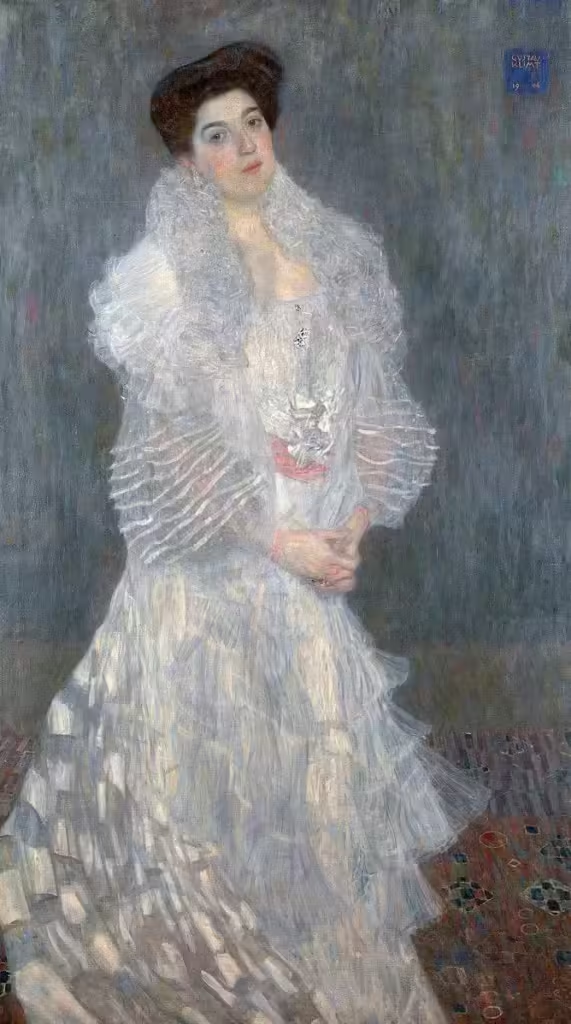
49- Portrait of Hermine Gallia – Gustav Klimt
Portrait of Hermine Gallia by Gustav Klimt, painted in 1903, is a distinguished and elegant representation of the Viennese socialite and patron. This portrait highlights Klimt’s early exploration of portraiture and his evolving decorative style.
In Portrait of Hermine Gallia, Klimt presents Hermine Gallia with an air of sophistication and poise. The painting captures her in a beautifully detailed gown, adorned with intricate patterns that reflect Klimt’s interest in texture and ornamentation. The background features a rich tapestry of colors and designs that complement the subject and enhance the overall composition.
Klimt’s use of color, light, and intricate detailing showcases his ability to blend realism with decorative elements. The painting reflects Gallia’s social status and elegance while demonstrating Klimt’s emerging signature style. Portrait of Hermine Gallia stands as a testament to Klimt’s skill in capturing both the personality and aesthetic beauty of his subjects.

50- Portrait of Johanna Staude – Gustav Klimt
Portrait of Johanna Staude by Gustav Klimt, painted in 1907, is an exquisite and refined work that captures the elegance and sophistication of its subject. Johanna Staude, a prominent Viennese socialite, is portrayed with a sense of grace and dignity that highlights Klimt’s mastery in portraiture.
In this portrait, Klimt depicts Staude in a richly decorated gown, set against a background of intricate patterns and textures. The use of delicate colors and ornamental details emphasizes Staude’s refined presence and the opulence of her attire. The composition reflects Klimt’s signature style, blending realistic portrayal with decorative art to create a visually captivating image.
The painting’s attention to detail and the interplay of color and pattern showcase Klimt’s ability to convey both personal character and artistic innovation. Portrait of Johanna Staude exemplifies Klimt’s talent for merging elegance with intricate design, resulting in a portrait that is both visually stunning and thematically resonant.
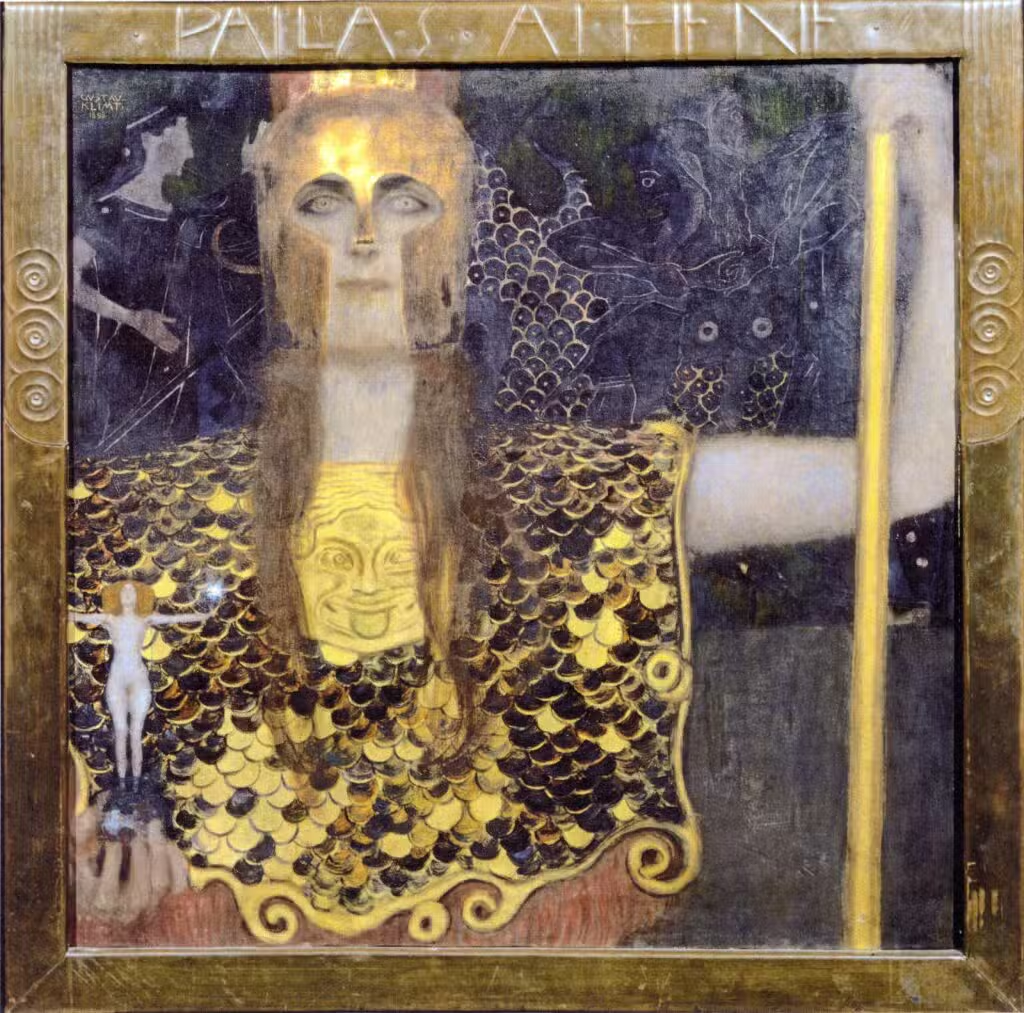
51- Pallas Athena – Gustav Klimt
Pallas Athena by Gustav Klimt, painted in 1898, is a notable work that reflects Klimt’s early interest in classical themes and his evolving artistic style. The painting depicts Pallas Athena, the ancient Greek goddess of wisdom and warfare, embodying both intellectual and martial prowess.
In Pallas Athena, Klimt presents the goddess in a regal and commanding pose, adorned with elaborate armor and a richly decorated background. The use of gold leaf and intricate patterns highlights Athena’s divine status and adds a sense of grandeur to the composition. Klimt’s attention to detail in the armor and ornamental elements demonstrates his skill in merging realistic and decorative elements.
The painting combines classical subject matter with Klimt’s distinctive style, blending symbolism and decorative art to create a powerful and visually striking image. Pallas Athena stands as an early example of Klimt’s ability to infuse traditional themes with his innovative artistic approach, showcasing both his technical skill and his fascination with mythological subjects.
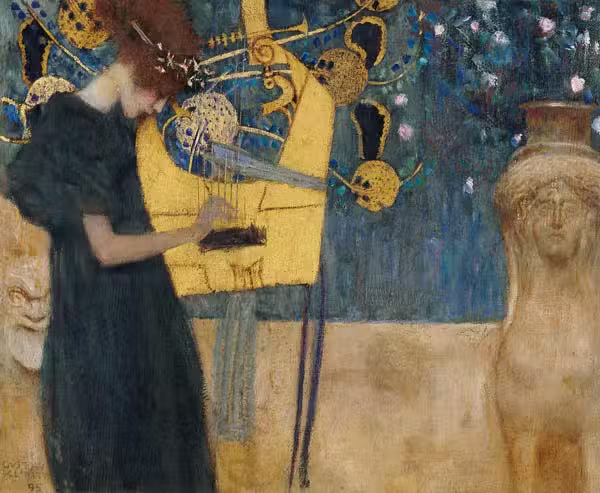
52- Music – Gustav Klimt
Music by Gustav Klimt, painted in 1895, is a captivating and symbolic work that delves into the interplay between art and music. This early masterpiece showcases Klimt’s emerging style and his fascination with the themes of harmony and rhythm.
In Music, Klimt depicts a female figure with a graceful and expressive demeanor, embodying the essence of music. The figure is surrounded by a richly decorative background, featuring intricate patterns and vibrant colors that suggest the fluidity and emotion of musical expression. The use of flowing lines and ornate details creates a sense of movement and harmony, reflecting the transformative power of music.
Klimt’s attention to detail and his innovative use of color and texture highlight the painting’s thematic depth and visual appeal. Music exemplifies Klimt’s ability to blend symbolic content with his distinctive decorative style, resulting in a work that is both visually striking and thematically resonant.

53- Goldfish – Gustav Klimt
Goldfish by Gustav Klimt, painted in 1901, is a vibrant and enchanting work that showcases Klimt’s fascination with nature and his skill in blending realism with decorative elements. This painting captures a moment of tranquility and beauty, featuring an elegant depiction of goldfish in a lush, ornamental setting.
In Goldfish, Klimt presents a serene aquatic scene with goldfish swimming amidst richly textured water plants and abstract patterns. The use of bold colors and intricate details highlights the fluidity and grace of the fish, while the background is adorned with Klimt’s signature decorative motifs, adding a sense of opulence and harmony.
The painting’s composition combines realistic portrayal with decorative art, creating a visually striking and thematically resonant work. Goldfish exemplifies Klimt’s ability to merge natural beauty with artistic innovation, resulting in a piece that is both captivating and aesthetically rich.
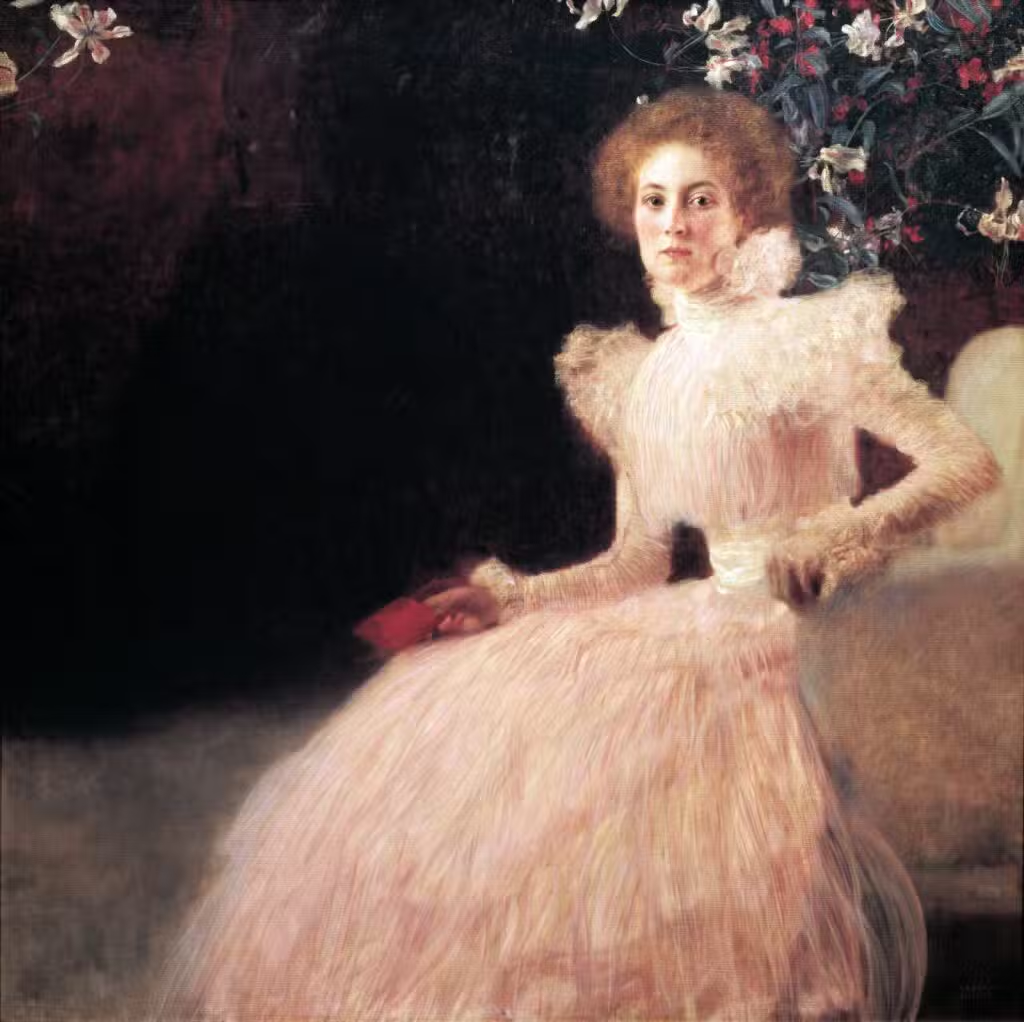
54- Portrait of Sonja Knips – Gustav Klimt
Portrait of Sonja Knips by Gustav Klimt, painted in 1898, is a distinguished work that captures the elegance and sophistication of its subject. Sonja Knips, a prominent Viennese socialite, is portrayed with a blend of realism and decorative artistry that characterizes Klimt’s early portrait style.
In Portrait of Sonja Knips, Klimt presents Sonja Knips in a refined and graceful manner, adorned in an ornate gown that reflects the fashion of the time. The painting features a rich and detailed background that complements the subject’s attire, incorporating Klimt’s signature patterns and textures.
The use of color and intricate detailing enhances the overall elegance of the portrait, highlighting Knips’s social status and the sophistication of her appearance. Portrait of Sonja Knips exemplifies Klimt’s ability to merge realistic representation with decorative elements, resulting in a work that is both visually striking and thematically resonant.

55- Portrait of Serena Lederer – Gustav Klimt
Portrait of Serena Lederer by Gustav Klimt, painted in 1899, is a captivating and elegant depiction of a Viennese society figure. This portrait is renowned for its graceful representation and the subtle integration of Klimt’s early decorative style.
In Portrait of Serena Lederer, Klimt portrays Serena Lederer in an elegant pose, adorned with a richly detailed gown that reflects the fashion of the late 19th century. The background and surrounding elements are adorned with intricate patterns and textures that complement the subject and enhance the overall composition. Klimt’s use of color and light brings out the refined beauty and sophistication of Lederer, while the ornamental details add depth and visual interest.
The painting combines a realistic portrayal of the subject with Klimt’s emerging decorative style, blending personal elegance with artistic innovation. Portrait of Serena Lederer stands as an example of Klimt’s ability to capture both the character and the beauty of his subjects while showcasing his distinctive approach to portraiture.

56- Portrait of Rose von Rosthorn-Friedmann – Gustav Klimt
Portrait of Rose von Rosthorn-Friedmann by Gustav Klimt, painted in 1900, is a striking and sophisticated work that captures the elegance and poise of its subject. Rose von Rosthorn-Friedmann, a notable Viennese socialite and philanthropist, is depicted with a sense of grace and refinement that highlights Klimt’s early mastery of portraiture.
In Portrait of Rose von Rosthorn-Friedmann, Klimt presents the subject in an elaborate gown, adorned with intricate patterns and textures that reflect the fashion and artistic trends of the time. The background features Klimt’s signature decorative motifs, enhancing the overall richness and depth of the composition.
The painting’s use of color, light, and detail emphasizes the subject’s elegance and social stature while integrating ornamental elements that create a harmonious and visually captivating image. Portrait of Rose von Rosthorn-Friedmann exemplifies Klimt’s skill in blending realistic portrayal with decorative artistry, resulting in a portrait that is both beautiful and thematically significant.
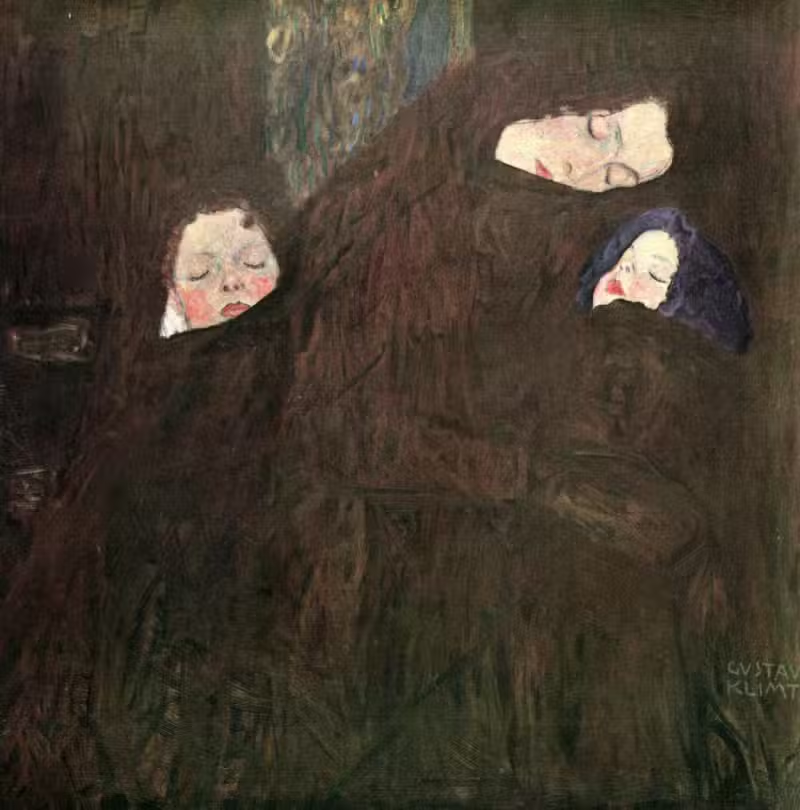
57- Mother with Children – Gustav Klimt
Mother with Children by Gustav Klimt, painted in 1905, is a poignant and evocative work that explores themes of motherhood and familial connection. This painting is notable for its tender depiction of a mother embracing her children, rendered with Klimt’s signature blend of realism and decorative elements.
In Mother with Children, Klimt portrays a nurturing and intimate scene, with the mother and her children surrounded by a richly detailed background. The use of flowing lines and intricate patterns creates a sense of warmth and harmony, reflecting the close bond between the figures. The painting’s color palette and texture emphasize the tenderness and emotional depth of the moment.
Klimt’s attention to detail and the incorporation of decorative motifs enhance the overall visual appeal of the painting, combining realistic portrayal with artistic innovation. Mother with Children stands as a testament to Klimt’s ability to convey profound emotional themes while showcasing his distinctive style and technical skill.
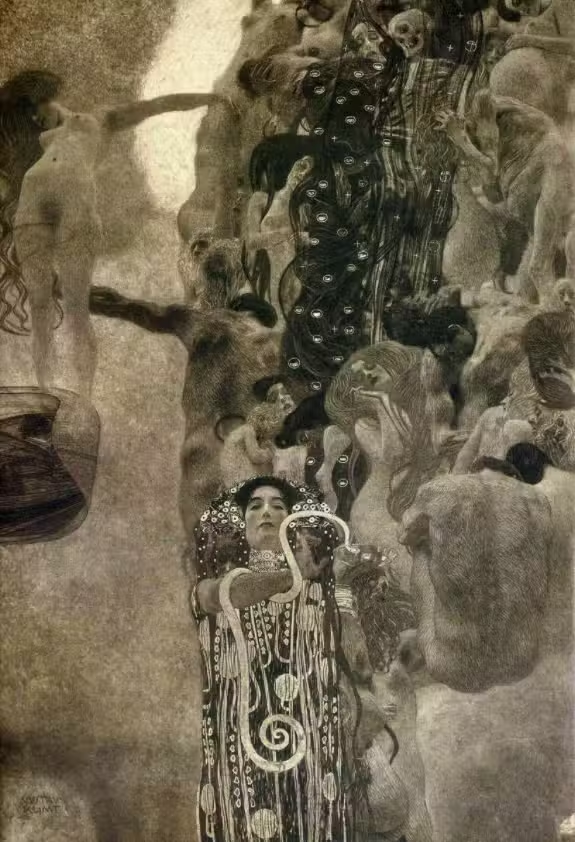
58- Medicine – Gustav Klimt
Medicine by Gustav Klimt, painted in 1900, is a monumental and symbolic work that forms part of a series of murals for the Vienna University’s ceiling, intended to represent the faculties of Medicine, Jurisprudence, and Philosophy. This painting is renowned for its rich allegorical content and intricate detail.
In Medicine, Klimt depicts the figure of Hygeia, the Greek goddess of health, as a central element of the composition. Surrounded by a multitude of figures and symbols related to medical science and healing, the painting combines allegorical elements with decorative patterns. The scene is framed by a complex arrangement of figures that symbolize the different aspects of medicine, from ancient wisdom to modern knowledge.
Klimt’s use of vibrant colors, elaborate patterns, and gold leaf creates a striking visual impact, while the integration of symbolic and allegorical elements adds depth to the painting’s thematic content. Medicine exemplifies Klimt’s ability to merge artistic innovation with thematic complexity, resulting in a work that is both visually stunning and rich in meaning.
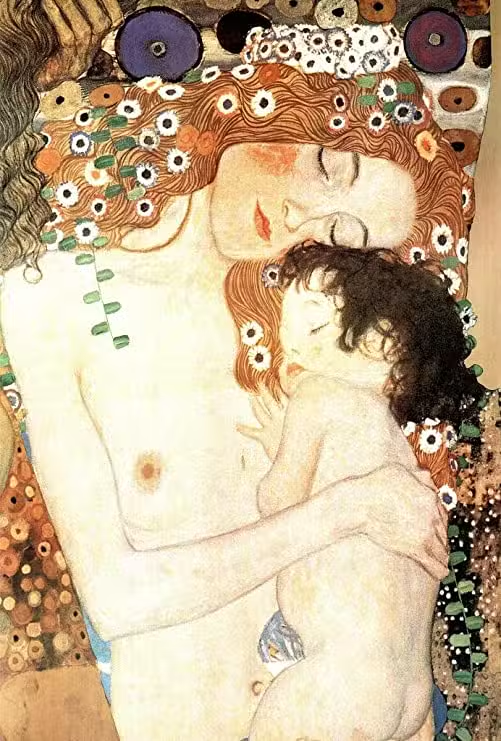
59- Mother and Child – Gustav Klimt
Mother and Child by Gustav Klimt, painted in 1905, is a tender and evocative work that explores the intimate bond between a mother and her child. This painting is celebrated for its emotional depth and Klimt’s distinctive decorative style.
In Mother and Child, Klimt depicts a nurturing and loving interaction between the mother and her infant, highlighting the warmth and tenderness of the maternal relationship. The figures are surrounded by a richly patterned background that incorporates Klimt’s signature ornamental motifs and use of gold, adding a sense of harmony and opulence to the composition.
The painting’s soft color palette and intricate details emphasize the gentle and protective nature of the mother’s embrace, while the decorative elements enhance the overall visual appeal of the piece. Mother and Child stands as a testament to Klimt’s ability to blend realistic portrayal with artistic embellishment, resulting in a work that is both emotionally resonant and aesthetically captivating.
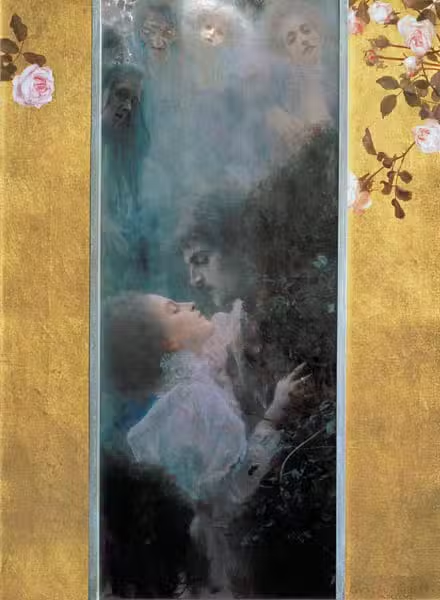
60- Love – Gustav Klimt
Love by Gustav Klimt, painted in 1905, is a profound and emotionally charged work that explores the theme of love through Klimt’s signature blend of symbolism and decorative artistry. This painting is renowned for its intricate composition and the depth of feeling it conveys.
In Love, Klimt depicts a passionate embrace between a couple, surrounded by an elaborate background that features a rich tapestry of patterns and textures. The figures are intertwined in a dynamic and sensual pose, with their bodies and the surrounding space rendered in Klimt’s characteristic ornamental style. The use of gold and vivid colors adds to the painting’s emotional intensity and visual impact.
The composition highlights the themes of intimacy and connection, with the decorative elements enhancing the overall sense of harmony and unity between the figures. Love exemplifies Klimt’s ability to merge emotional depth with artistic innovation, resulting in a work that is both visually stunning and thematically resonant.
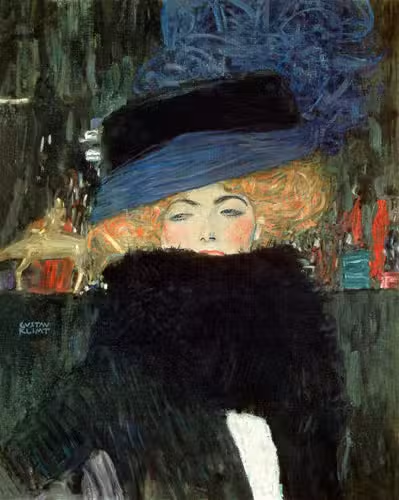
61- Lady with Hat and Boa – Gustav Klimt
Lady with Hat and Boa by Gustav Klimt, painted in 1909, is a striking and elegant portrait that captures the sophistication and style of its subject. This painting showcases Klimt’s skill in blending realistic portrayal with his distinctive decorative elements.
In Lady with Hat and Boa, Klimt depicts a woman adorned with a stylish hat and a luxurious boa, rendered with meticulous attention to detail. The figure’s attire is complemented by a richly decorated background featuring Klimt’s signature ornamental patterns and textures. The use of bold colors and intricate designs creates a sense of opulence and refinement.
The painting’s composition emphasizes the subject’s elegance and the fashionable details of her outfit, while the decorative elements enhance the overall visual appeal. Lady with Hat and Boa exemplifies Klimt’s ability to merge personal elegance with artistic innovation, resulting in a portrait that is both visually captivating and stylistically significant.
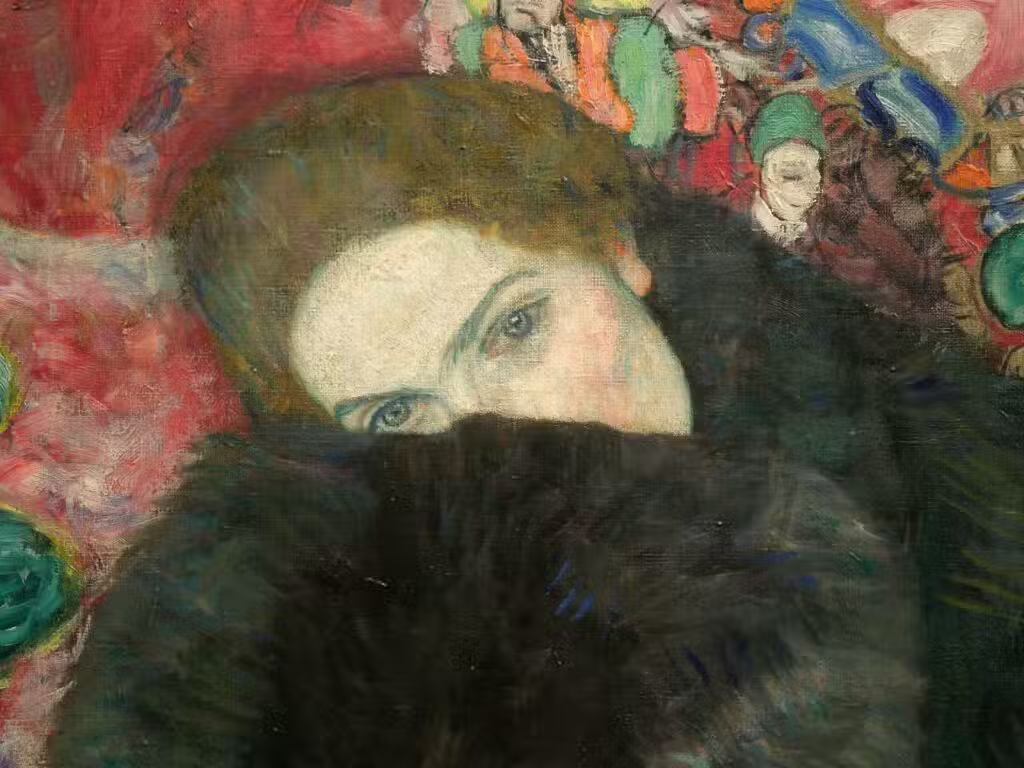
62- Lady with a Muff – Gustav Klimt
Lady with a Muff by Gustav Klimt, painted in 1897, is an elegant and refined portrait that captures the sophistication and poise of its subject. This painting exemplifies Klimt’s early approach to portraiture, blending realistic depiction with decorative elements.
In Lady with a Muff, Klimt portrays a woman holding a fur muff, dressed in a beautifully detailed gown that reflects the fashion of the late 19th century. The background features Klimt’s characteristic patterns and textures, adding a sense of richness and complexity to the composition. The use of color and intricate detailing highlights the subject’s elegance and the opulence of her attire.
The painting’s composition combines a realistic portrayal of the subject with Klimt’s decorative style, resulting in a work that is both visually captivating and thematically resonant. Lady with a Muff stands as an example of Klimt’s skill in merging personal elegance with artistic innovation.
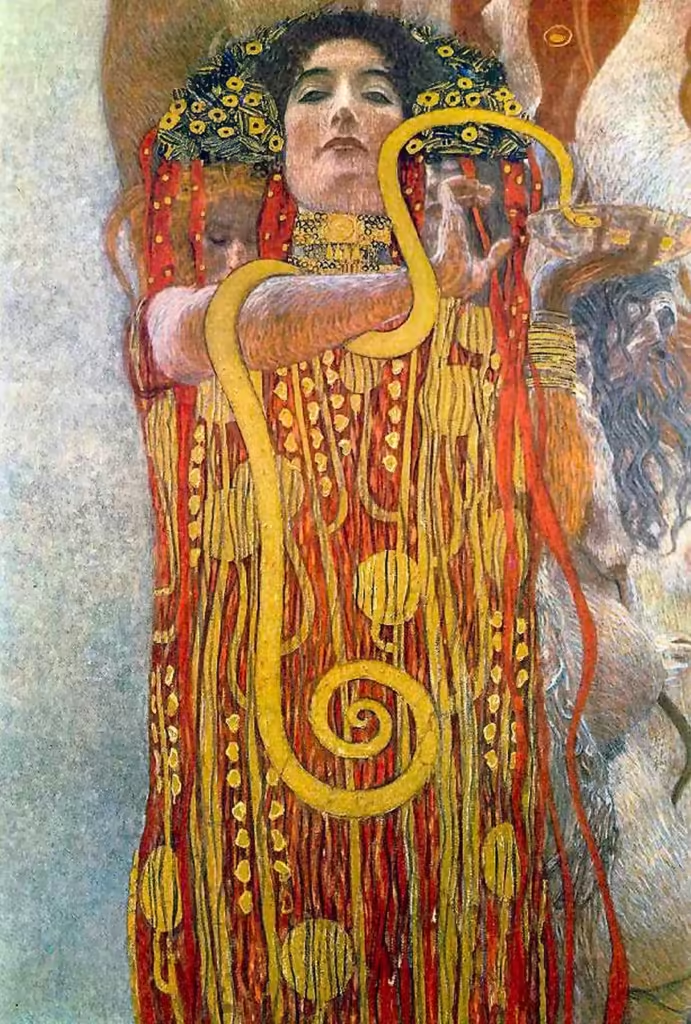
63- Hygieia – Medicine (Detail) – Gustav Klimt
Hygieia – Medicine (Detail) by Gustav Klimt is a segment of the larger mural Klimt created for the Vienna University ceiling in 1900, which represents the theme of Medicine. This detail focuses on Hygieia, the Greek goddess of health, who is central to the composition.
In this detail, Klimt portrays Hygieia in a dignified and serene pose, embodying the essence of health and healing. The depiction is surrounded by elaborate patterns and symbolic elements that highlight the goddess’s role in the theme of medicine. The use of gold leaf and intricate designs showcases Klimt’s signature style, merging symbolic content with decorative art.
The detail captures Klimt’s ability to combine mythological themes with his innovative decorative approach, creating a visually striking and thematically rich representation. Hygieia – Medicine (Detail) exemplifies Klimt’s skill in blending symbolic meaning with artistic beauty, resulting in a work that is both captivating and profound.

64- Idyll – Gustav Klimt
Idyll by Gustav Klimt, painted in 1884, is an early work that reflects Klimt’s fascination with themes of beauty and nature. This painting, created during Klimt’s formative years, showcases his emerging style and interest in combining realistic elements with a decorative approach.
In Idyll, Klimt depicts a serene and harmonious scene of a young woman surrounded by a lush, natural setting. The composition features intricate details and a rich color palette that highlight the beauty and tranquility of the scene. The figure is portrayed with a sense of grace and calm, while the background is adorned with decorative patterns that enhance the overall visual appeal.
The painting’s combination of realistic portrayal and ornamental elements demonstrates Klimt’s early exploration of his signature style, blending natural beauty with artistic innovation. Idyll stands as a testament to Klimt’s ability to capture both the essence of his subjects and the aesthetic richness of his art.
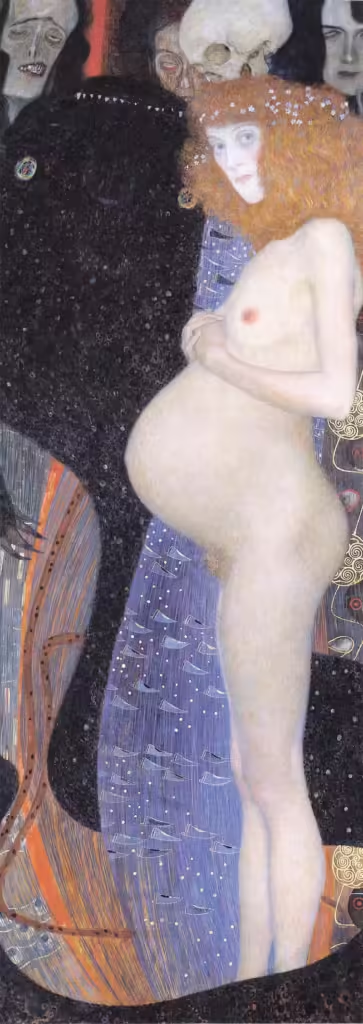
65- Hope I – Gustav Klimt
Hope I by Gustav Klimt, painted in 1903, is a poignant and evocative work that explores themes of maternal love and vulnerability. This painting is renowned for its emotional depth and Klimt’s distinctive artistic style.
In Hope I, Klimt depicts a pregnant woman in a solemn and introspective pose, surrounded by a richly decorated background. The figure is portrayed with a sense of vulnerability and tenderness, capturing the complex emotions associated with impending motherhood. The use of intricate patterns and muted colors adds to the painting’s emotional resonance, while Klimt’s characteristic ornamental style enhances the overall composition.
The painting combines realistic depiction with symbolic and decorative elements, reflecting Klimt’s ability to convey profound emotional themes through his unique artistic approach. Hope I stands as a powerful representation of maternal anticipation and the beauty of human emotion, showcasing Klimt’s skill in merging personal and artistic depth.
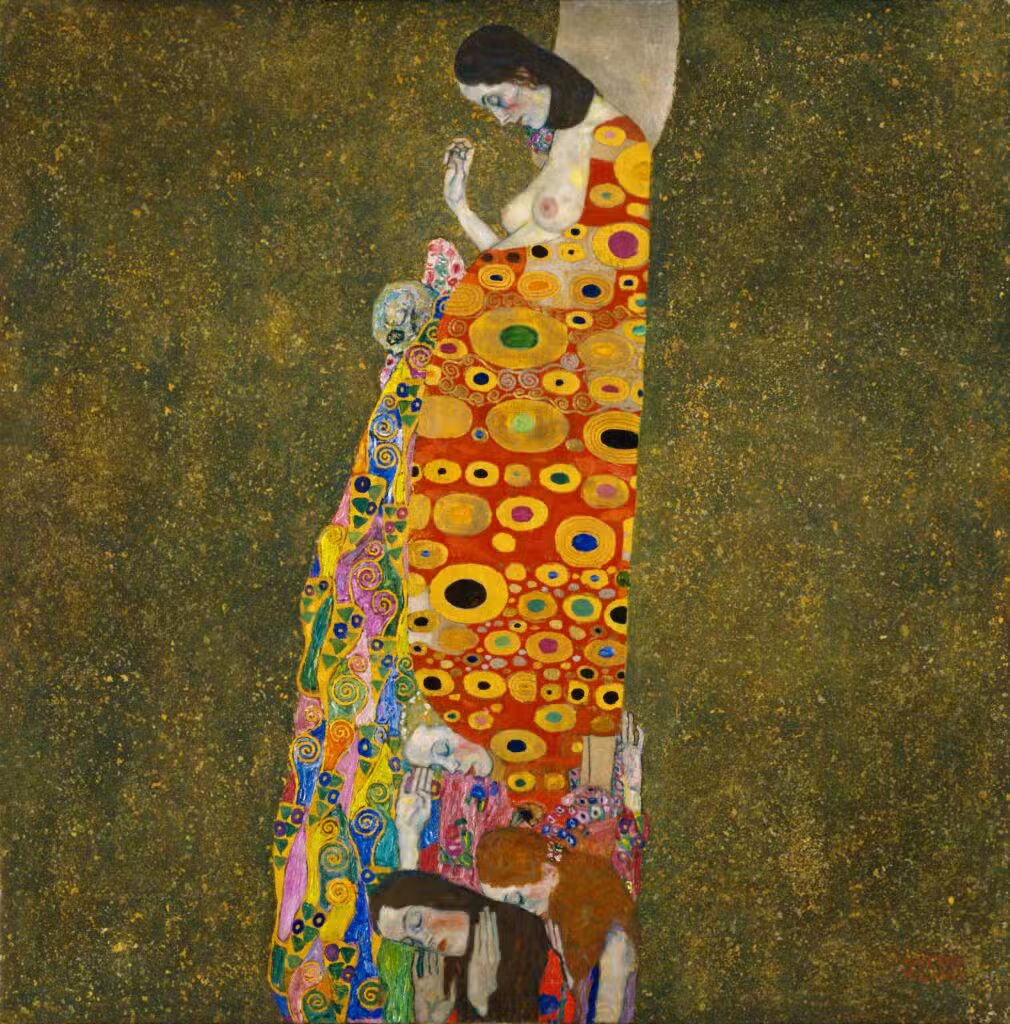
66- Hope II – Gustav Klimt
Hope II by Gustav Klimt, painted in 1907-1908, is a deeply emotional and symbolic work that continues the themes of maternity and anticipation explored in Klimt’s earlier Hope I. This painting is notable for its dramatic and poignant portrayal of the struggles and hopes associated with motherhood.
In Hope II, Klimt presents a pregnant woman in a strikingly intimate and expressive pose. The figure is surrounded by a richly decorative background filled with intricate patterns and symbolic motifs. The painting captures the woman’s emotional complexity, reflecting both the beauty and anxiety of her condition. The use of vibrant colors and Klimt’s distinctive ornamental style adds depth to the composition, enhancing the emotional impact of the work.
The painting’s combination of realistic depiction and decorative elements showcases Klimt’s ability to convey profound personal and thematic content through his art. Hope II stands as a powerful testament to Klimt’s skill in exploring the human experience and the emotional depth of his subjects.

67- The Portrait of a Lady in White – Gustav Klimt
The Portrait of a Lady in White by Gustav Klimt, painted in 1917-1918, is a sophisticated and evocative portrait that exemplifies Klimt’s mature style and his skill in blending realism with decorative elements. This painting captures the elegance and poise of its subject, showcasing Klimt’s signature approach to portraiture.
In The Portrait of a Lady in White, Klimt depicts the subject in a refined white gown, surrounded by a richly patterned background that features intricate designs and ornamental details. The use of light and color highlights the subject’s elegance and the luxuriousness of her attire. Klimt’s characteristic use of gold and decorative patterns adds a sense of depth and opulence to the composition.
The portrait combines a realistic portrayal of the subject with Klimt’s distinctive decorative style, resulting in a work that is both visually stunning and thematically rich. The Portrait of a Lady in White stands as a testament to Klimt’s ability to merge personal elegance with artistic innovation, creating a portrait that is both captivating and reflective of his unique artistic vision.

68- The Sunflower – Gustav Klimt
The Sunflower by Gustav Klimt, painted in 1907, is a vibrant and captivating work that showcases Klimt’s fascination with natural forms and his distinctive decorative style. This painting highlights Klimt’s ability to blend realism with ornamental art.
In The Sunflower, Klimt presents a single, richly detailed sunflower in full bloom. The composition focuses on the flower’s intricate patterns and textures, reflecting Klimt’s keen observation of nature and his skill in capturing its beauty. The background features Klimt’s characteristic decorative elements, with a blend of colors and patterns that complement the central sunflower and enhance the overall visual impact of the painting.

69- Silver Fish – Gustav Klimt
Silver Fish by Gustav Klimt, painted in 1900, is an elegant and captivating work that highlights Klimt’s fascination with natural forms and his skill in combining realism with decorative elements. This painting is noted for its intricate portrayal of aquatic life and its distinctive use of color and texture.
In Silver Fish, Klimt depicts a group of fish with shimmering scales, rendered in detailed silver and gray tones. The fish are set against a background of elaborate patterns and textures that enhance their visual impact. Klimt’s use of color and intricate detailing creates a sense of fluidity and movement, reflecting the natural beauty of the aquatic scene.
The painting’s combination of realistic depiction with decorative motifs showcases Klimt’s ability to merge natural observation with artistic innovation. Silver Fish exemplifies Klimt’s skill in creating visually striking works that blend thematic content with his distinctive style, resulting in a piece that is both aesthetically pleasing and thematically rich.
The painting’s use of bold colors and detailed brushwork brings the sunflower to life, while the surrounding decorative motifs add depth and richness to the composition. The Sunflower stands as an example of Klimt’s ability to merge natural beauty with artistic innovation, resulting in a work that is both visually striking and thematically resonant.

70- Young Girl Seated – Gustav Klimt
Young Girl Seated by Gustav Klimt, painted in 1917-1918, is a refined and introspective portrait that captures the grace and elegance of its young subject. This painting exemplifies Klimt’s mature style, blending realism with his signature decorative elements.
In Young Girl Seated, Klimt portrays a young woman in a serene and contemplative pose. The figure is depicted with delicate attention to detail, highlighting her youthful grace and poise. The background is adorned with intricate patterns and ornamental designs that complement the subject and enhance the overall composition. Klimt’s use of color, light, and texture adds depth and visual interest to the painting.
The painting combines a realistic representation of the subject with Klimt’s distinctive artistic style, resulting in a work that is both visually captivating and thematically resonant. Young Girl Seated stands as a testament to Klimt’s ability to capture the essence of his subjects while showcasing his innovative approach to portraiture.

71- Death and Life – Gustav Klimt
Death and Life by Gustav Klimt, painted in 1910, is a profound and symbolic work that explores the themes of mortality and the cycle of life. This painting is renowned for its emotional depth and Klimt’s distinctive use of color and symbolism.
In Death and Life, Klimt presents a dramatic juxtaposition of two contrasting themes: the figure of Death and a group of life-affirming, interconnected figures. The central motif features a skeletal figure representing Death, surrounded by a swirling, vibrant array of life forms, including figures in various states of repose and vitality. The composition is rich with intricate patterns and textures that reflect Klimt’s signature ornamental style.
The painting’s use of vivid colors and detailed design enhances the contrast between the somber figure of Death and the dynamic, colorful representation of life. Death and Life exemplifies Klimt’s ability to convey complex emotional and philosophical themes through his unique artistic vision, resulting in a work that is both visually striking and thematically resonant.

72- Cows in the Stable – Gustav Klimt
Cows in the Stable by Gustav Klimt, painted in 1919, is a charming and detailed work that reflects Klimt’s interest in rural and natural themes. This painting showcases his ability to blend realism with his characteristic decorative style.
In Cows in the Stable, Klimt presents a serene and intimate scene of cows resting in a stable. The animals are depicted with careful attention to detail, highlighting their forms and textures. The background features a richly patterned environment that adds a decorative element to the composition. Klimt’s use of color and pattern enhances the overall sense of calm and harmony in the scene.
The painting’s combination of realistic portrayal and decorative artistry demonstrates Klimt’s skill in capturing the essence of his subjects while incorporating his distinctive style. Cows in the Stable stands as an example of Klimt’s ability to explore everyday themes through his innovative approach, resulting in a work that is both visually appealing and thematically significant.
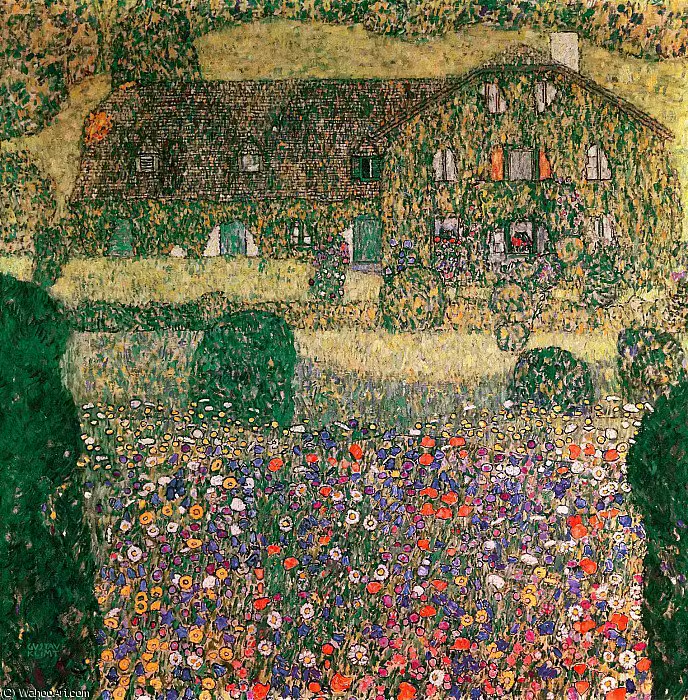
73- Country House on the Attersee – Gustav Klimt
Country House on the Attersee by Gustav Klimt, painted in 1914, is a serene and picturesque work that captures the tranquil beauty of a rural setting. This painting reflects Klimt’s fascination with landscapes and his ability to infuse natural scenes with his distinctive style.
In Country House on the Attersee, Klimt depicts a charming country house nestled by the shores of Lake Attersee. The scene is rendered with a harmonious color palette and detailed brushwork that highlights the peacefulness of the setting. The lush greenery and calm waters are portrayed with a sense of depth and tranquility, enhanced by Klimt’s characteristic decorative elements.
The painting’s composition showcases Klimt’s skill in capturing the essence of rural life while incorporating his unique artistic touch. Country House on the Attersee stands as a testament to Klimt’s ability to convey the beauty of nature and the serenity of the countryside through his innovative approach to landscape painting.

74- Countryside Garden with Cross – Gustav Klimt
Countryside Garden with Cross by Gustav Klimt, painted in 1913, is a serene and contemplative work that beautifully captures the charm of rural landscapes while incorporating symbolic elements. This painting reflects Klimt’s interest in integrating natural beauty with thematic content.
In Countryside Garden with Cross, Klimt depicts a tranquil garden scene with lush greenery, blooming flowers, and a prominent cross in the composition. The garden is portrayed with a harmonious blend of colors and textures, showcasing Klimt’s characteristic attention to detail and ornamental style. The cross adds a symbolic layer to the scene, suggesting themes of faith and spirituality amidst the natural setting.
The painting’s use of vibrant colors and intricate patterns enhances the overall visual appeal, while the combination of realistic depiction and symbolic elements highlights Klimt’s ability to convey deeper meanings through his art. Countryside Garden with Cross stands as an example of Klimt’s skill in merging natural beauty with thematic richness, resulting in a work that is both visually captivating and thought-provoking.

75- Beethoven Frieze – Gustav Klimt
Beethoven Frieze by Gustav Klimt, completed in 1902, is a monumental and symbolic work created for the Beethoven Exhibition in Vienna. This frieze is celebrated for its intricate composition and the way it embodies the emotional and philosophical themes of Beethoven’s music.
The Beethoven Frieze is a large-scale mural that visually interprets the themes of Beethoven’s Ninth Symphony. Klimt’s design is divided into three sections: the first represents the struggle of humanity, the second depicts the concept of beauty and love as redemptive forces, and the third illustrates the triumph of humanity and the union with the divine.
The frieze features a blend of symbolic figures, intricate patterns, and vibrant colors. Klimt’s signature use of gold leaf and decorative motifs enhances the mural’s grandeur and emotional impact. The depiction of mythological figures and allegorical scenes is both visually striking and thematically profound, reflecting Klimt’s innovative approach to art and his ability to convey complex ideas through his unique style.
The Beethoven Frieze stands as a testament to Klimt’s skill in merging artistic decoration with profound thematic content, creating a work that is both an aesthetic marvel and a powerful interpretation of musical and philosophical ideas.

76- Baby (Cradle) – Gustav Klimt
Baby (Cradle) by Gustav Klimt, painted in 1917, is a tender and evocative work that captures the innocence and vulnerability of infancy. This painting reflects Klimt’s ability to blend emotional depth with his distinctive decorative style.
In Baby (Cradle), Klimt portrays a young child resting in a cradle, surrounded by a serene and nurturing environment. The figure of the baby is rendered with delicate brushstrokes and a gentle color palette, emphasizing the fragility and purity of the subject. The background features Klimt’s signature ornamental patterns, which add a layer of texture and richness to the composition.
The painting’s use of soft colors and intricate designs enhances the overall sense of calm and tenderness, while Klimt’s characteristic style brings a unique visual charm to the scene. Baby (Cradle) stands as an example of Klimt’s skill in capturing intimate moments and conveying profound emotional themes through his art, resulting in a work that is both visually appealing and deeply resonant.
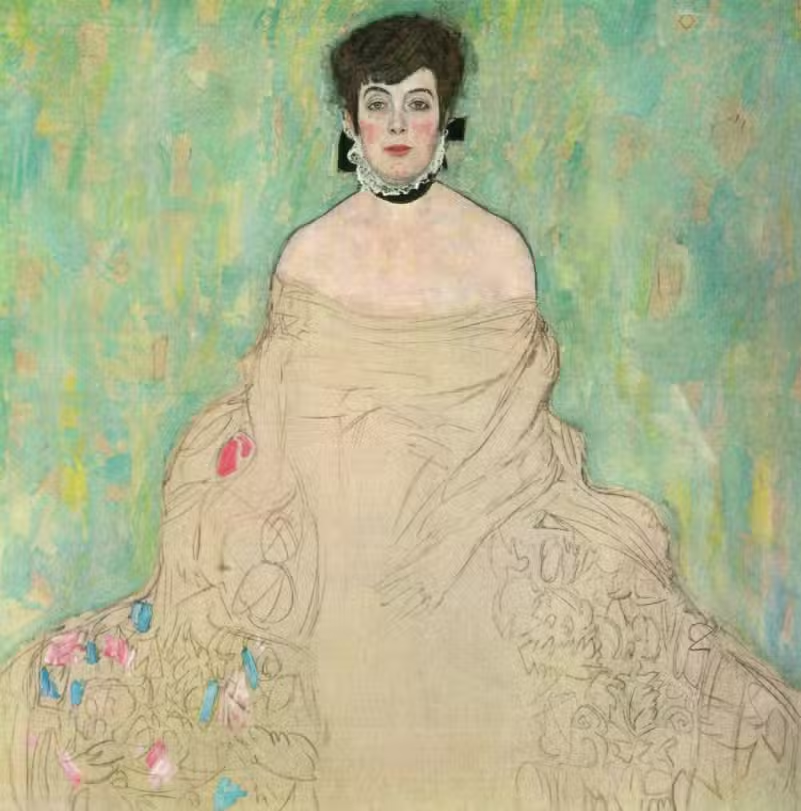
77- Amalie Zuckerkandl – Gustav Klimt
Amalie Zuckerkandl by Gustav Klimt, painted in 1917, is a sophisticated and elegant portrait that showcases Klimt’s skill in capturing the essence of his subjects through his distinctive artistic style. This portrait is a striking example of Klimt’s mature period, reflecting his ability to blend realism with ornamental elements.
In Amalie Zuckerkandl, Klimt depicts the subject, Amalie Zuckerkandl, a prominent Viennese society figure, with refined detail and elegance. The portrait features Zuckerkandl in a luxurious gown, adorned with intricate patterns and textures that reflect Klimt’s characteristic decorative style. The use of rich colors and elaborate designs highlights the subject’s sophistication and the opulence of her attire.
The background is adorned with Klimt’s signature ornamental motifs, adding depth and visual interest to the composition. The painting combines a realistic portrayal of the subject with Klimt’s unique artistic approach, resulting in a work that is both visually captivating and thematically rich. Amalie Zuckerkandl stands as a testament to Klimt’s skill in merging personal elegance with artistic innovation, creating a portrait that is both striking and reflective of his artistic vision.

78- Ancient Egypt (Isis) – Gustav Klimt
Ancient Egypt (Isis) by Gustav Klimt, painted in 1899, is an intriguing and richly detailed work that reflects Klimt’s early interest in historical and mythological themes. This painting is notable for its depiction of the ancient Egyptian goddess Isis, rendered with Klimt’s characteristic attention to detail and ornamental style.
In Ancient Egypt (Isis), Klimt presents the figure of Isis, the revered goddess of fertility and motherhood, adorned with elaborate Egyptian-inspired patterns and symbols. The painting features a harmonious blend of vibrant colors and intricate designs, capturing the mystique and grandeur of ancient Egyptian art. The background is adorned with decorative motifs that enhance the overall visual impact of the piece.
The painting’s combination of realistic depiction and decorative elements showcases Klimt’s early exploration of integrating historical themes with his unique artistic vision. Ancient Egypt (Isis) stands as a testament to Klimt’s skill in creating visually captivating works that reflect both historical significance and artistic innovation.

79- Adam and Eve – Gustav Klimt
Adam and Eve by Gustav Klimt, painted in 1917, is a compelling and symbolic work that explores themes of creation, temptation, and the human condition. This painting is notable for its rich symbolism and Klimt’s distinctive decorative style.
In Adam and Eve, Klimt presents the biblical figures of Adam and Eve in a dramatic and intricate composition. The figures are depicted with a blend of realism and symbolic elements, surrounded by a richly decorated background that features Klimt’s signature patterns and ornamental details. The painting captures the moment of the fall from grace, with the figures expressing a sense of vulnerability and introspection.
Klimt’s use of vibrant colors and detailed textures enhances the emotional impact of the painting, while the integration of decorative motifs adds depth and richness to the composition. Adam and Eve stands as a testament to Klimt’s ability to convey complex themes through his unique artistic vision, resulting in a work that is both visually striking and thematically profound.

80- Allegory of Sculpture – Gustav Klimt
Allegory of Sculpture by Gustav Klimt, painted in 1889, is an evocative and symbolic work that represents the art of sculpture through a blend of allegorical imagery and ornamental detail. This painting is part of Klimt’s early career, reflecting his interest in merging artistic symbolism with visual aesthetics.
In Allegory of Sculpture, Klimt depicts a female figure personifying the art of sculpture. She is portrayed with a classical grace and surrounded by a richly patterned background that highlights Klimt’s decorative style. The figure’s pose and expression convey a sense of serenity and contemplation, emphasizing the intellectual and artistic nature of sculpture.
The painting features Klimt’s signature use of elaborate patterns and textures, which enhance the overall composition and add depth to the symbolic representation of sculpture. Allegory of Sculpture stands as an example of Klimt’s ability to integrate thematic content with his distinctive artistic approach, resulting in a work that is both visually captivating and rich in symbolic meaning.

81- Actor Josef Lewinsky: Carlos – Gustav Klimt
Actor Josef Lewinsky: Carlos by Gustav Klimt, painted in 1899, is a notable portrait that captures the essence of Josef Lewinsky, a prominent Viennese actor of the time. This painting reflects Klimt’s early career and his skill in portraying his subjects with both realism and artistic flair.
In Actor Josef Lewinsky: Carlos, Klimt presents Lewinsky in a dramatic and expressive pose, highlighting his theatrical presence. The portrait features detailed attention to Lewinsky’s costume and features, capturing his charisma and the essence of his role as “Carlos.” The background and composition are adorned with Klimt’s early decorative elements, adding a layer of sophistication and visual interest to the portrait.
The painting combines realistic depiction with Klimt’s developing decorative style, resulting in a work that is both visually engaging and reflective of Lewinsky’s role in the arts. Actor Josef Lewinsky: Carlos stands as a testament to Klimt’s early ability to capture the personality and significance of his subjects through his unique artistic vision.

82- Countryside Garden with Sunflowers – Gustav Klimt
Countryside Garden with Sunflowers by Gustav Klimt, painted in 1913, is a vibrant and enchanting work that captures the beauty of nature through Klimt’s distinctive artistic lens. This painting reflects Klimt’s interest in integrating natural themes with his signature decorative style.
In Countryside Garden with Sunflowers, Klimt portrays a picturesque garden scene filled with blooming sunflowers and lush greenery. The sunflowers, depicted with intricate detail and vivid colors, stand out against a background adorned with Klimt’s characteristic ornamental patterns. The composition creates a harmonious blend of natural beauty and decorative richness.
The painting’s use of bold colors and detailed textures enhances the overall visual appeal, while the integration of decorative elements adds depth and sophistication to the scene. Countryside Garden with Sunflowers exemplifies Klimt’s ability to merge realistic depiction with artistic innovation, resulting in a work that is both visually striking and evocative of the serene beauty of the countryside.

83- Design of a Painted Composition on Medicine – Gustav Klimt
Design of a Painted Composition on Medicine by Gustav Klimt, created in 1901, is a significant work that reflects Klimt’s interest in incorporating thematic and symbolic elements into his art. This design was part of a larger project intended for a mural that explores themes related to medicine and healing.
In this composition, Klimt presents a richly detailed and symbolic interpretation of medicine. The design features allegorical figures and motifs associated with health and wellness, rendered with Klimt’s signature ornamental style. The use of gold leaf and intricate patterns enhances the visual impact and adds a layer of depth to the thematic content.
The composition is characterized by its elaborate decoration and the integration of symbolic elements, reflecting Klimt’s ability to merge artistic beauty with conceptual depth. Design of a Painted Composition on Medicine stands as an example of Klimt’s innovative approach to integrating thematic content with his unique artistic vision, resulting in a work that is both visually captivating and thematically significant.

84- Emilie Flöge – Gustav Klimt
Emilie Flöge by Gustav Klimt, painted in 1902, is a notable portrait of Emilie Flöge, a close companion and muse of Klimt. This painting exemplifies Klimt’s skill in capturing the personality and elegance of his subjects through his distinctive artistic style.
In Emilie Flöge, Klimt portrays Flöge with a combination of realism and decorative flair. She is depicted in an elegant pose, adorned in a stylish gown that features intricate patterns and textures, reflecting Klimt’s interest in fashion and design. The background is adorned with Klimt’s characteristic ornamental motifs, adding depth and visual interest to the composition.
The painting’s use of vibrant colors and detailed patterns highlights Flöge’s sophistication and the intimate connection between the artist and his subject. Emilie Flöge stands as a testament to Klimt’s ability to blend personal elegance with artistic innovation, resulting in a portrait that is both visually striking and reflective of his unique artistic vision.

85- Two Girls with a Oleander – Gustav Klimt
Two Girls with a Oleander by Gustav Klimt, painted in 1890, is an enchanting and intimate work that captures the innocence and beauty of its young subjects. This early painting by Klimt reflects his skill in blending realistic portraiture with a touch of decorative elegance.
In Two Girls with a Oleander, Klimt depicts two young women, likely in a garden setting, each holding a branch of oleander. The painting is characterized by its soft color palette and detailed rendering of the subjects’ attire and the floral elements. The background features Klimt’s early decorative style, with delicate patterns and textures that complement the figures and add depth to the composition.
The use of light and shadow enhances the sense of realism, while the incorporation of decorative elements highlights Klimt’s developing style. Two Girls with a Oleander stands as a beautiful example of Klimt’s ability to capture the grace and charm of his subjects, blending realism with a touch of artistic embellishment.

86- Villa on the Attersee – Gustav Klimt
Villa on the Attersee by Gustav Klimt, painted in 1914, is a serene and picturesque work that captures the beauty of a tranquil lakeside residence. This painting reflects Klimt’s fascination with landscape and architecture, showcasing his ability to blend natural and built environments with his distinctive artistic style.
In Villa on the Attersee, Klimt depicts a charming villa set against the backdrop of the lush landscape surrounding Lake Attersee. The painting features a detailed representation of the villa’s architecture, surrounded by verdant greenery and calm waters. Klimt’s use of color and composition highlights the peaceful and idyllic setting, while his signature ornamental patterns subtly enhance the scene.
The painting’s combination of realistic detail and decorative elements creates a harmonious and visually appealing composition. Villa on the Attersee stands as an example of Klimt’s ability to capture the essence of a serene and picturesque environment, blending architectural precision with his unique artistic touch.

87- The Waiting – Gustav Klimt
The Waiting by Gustav Klimt, painted in 1917, is a poignant and evocative work that explores themes of anticipation and emotional depth. This painting reflects Klimt’s ability to convey complex emotions through his distinctive artistic style.
In The Waiting, Klimt portrays a solitary figure, depicted with a sense of introspection and longing. The subject is rendered with Klimt’s characteristic attention to detail, and the composition is enhanced by his signature use of rich colors and ornamental patterns. The background and surrounding elements are designed to complement the central figure, adding depth and context to the scene.
The painting’s use of color and texture creates a mood of contemplation and emotional depth, while Klimt’s decorative motifs add a layer of visual interest. The Waiting stands as an example of Klimt’s skill in capturing nuanced emotional states and conveying them through his unique artistic vision.
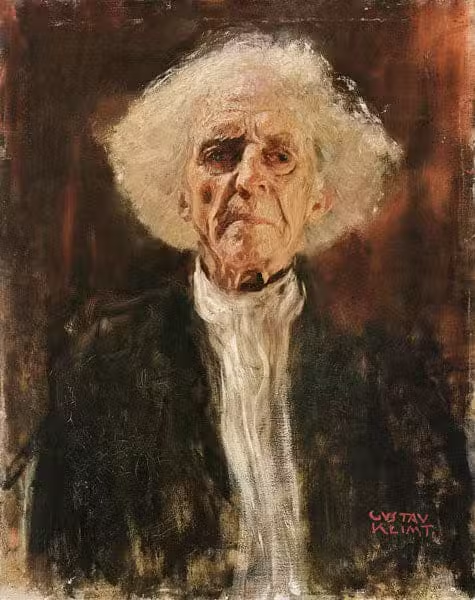
88- Study of the Head of a Blind Man – Gustav Klimt
Study of the Head of a Blind Man by Gustav Klimt, painted in 1907, is a striking and introspective work that reflects Klimt’s exploration of human emotion and condition. This study showcases Klimt’s skill in capturing the essence of his subjects through a combination of detailed observation and artistic expression.
In Study of the Head of a Blind Man, Klimt presents a close-up view of an elderly man, his blind eyes closed in a contemplative expression. The portrait is characterized by its focus on the textures and lines of the man’s face, rendered with Klimt’s characteristic precision and attention to detail. The study highlights the emotional and psychological depth of the subject, emphasizing the sense of vulnerability and introspection.
The painting’s use of subtle colors and intricate brushwork enhances the overall impact, while Klimt’s decorative elements are subtly incorporated to complement the portrait. Study of the Head of a Blind Man stands as a testament to Klimt’s ability to capture the profound emotional and physical aspects of his subjects, offering a deeply personal and evocative portrayal.
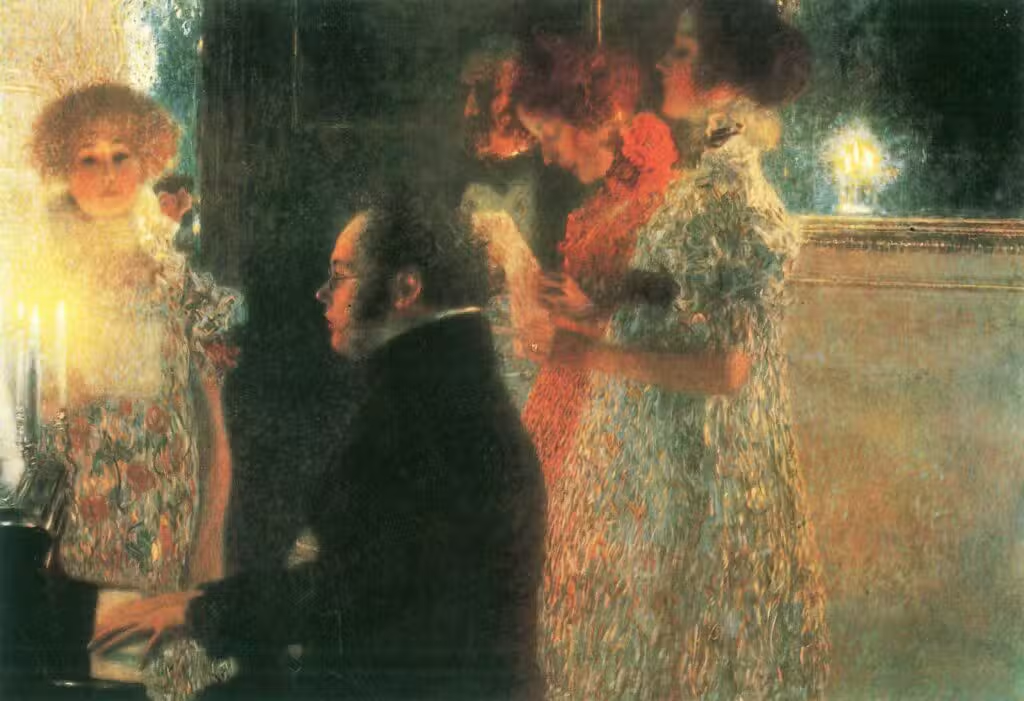
89- Schubert at the Piano II – Gustav Klimt
Schubert at the Piano II by Gustav Klimt, painted in 1899, is a notable work that captures the essence of the composer Franz Schubert in a moment of musical inspiration. This painting reflects Klimt’s ability to blend realism with his emerging decorative style.
In Schubert at the Piano II, Klimt presents Schubert seated at a piano, deeply engrossed in his music. The composition highlights Schubert’s expression of concentration and creativity, with the figure rendered in detailed and realistic manner. The background features Klimt’s early decorative elements, which enhance the atmosphere of the scene and add a layer of visual interest.
The painting’s use of color and texture creates a sense of intimacy and focus, while the incorporation of ornamental motifs subtly enriches the overall composition. Schubert at the Piano II stands as an example of Klimt’s skill in portraying significant cultural figures, capturing both their artistic spirit and his unique artistic approach.

90- Portrait of Adele Bloch-Bauer II – Gustav Klimt
Portrait of Adele Bloch-Bauer II by Gustav Klimt, painted in 1912, is a sophisticated and richly detailed portrait that continues Klimt’s exploration of his muse, Adele Bloch-Bauer. This painting is a sequel to the earlier Portrait of Adele Bloch-Bauer I and reflects Klimt’s evolving style and his deep connection with his subject.
In Portrait of Adele Bloch-Bauer II, Klimt portrays Adele Bloch-Bauer with a combination of realism and decorative elegance. Adele is depicted in a poised and graceful manner, dressed in an opulent gown adorned with intricate patterns. The background features Klimt’s characteristic ornamental elements, creating a harmonious and visually captivating composition.
The use of vibrant colors, elaborate textures, and Klimt’s signature gold leaf enhance the painting’s overall richness and depth. The portrait captures Adele’s elegance and the intimate rapport between the artist and his subject, making Portrait of Adele Bloch-Bauer II a testament to Klimt’s skill in blending personal elegance with artistic innovation.

91- Path in the Park of Schloss Kammer – Gustav Klimt
Path in the Park of Schloss Kammer by Gustav Klimt, painted in 1912, is a serene and evocative landscape that captures the tranquil beauty of a park setting. This painting reflects Klimt’s interest in integrating natural themes with his distinctive decorative style.
In Path in the Park of Schloss Kammer, Klimt depicts a winding path through a lush park, with the backdrop of the Schloss Kammer, a picturesque castle by Lake Attersee. The composition features a harmonious blend of natural elements and Klimt’s signature ornamental patterns. The path is flanked by trees and foliage, rendered with a keen attention to detail and a vibrant color palette.
The painting’s use of color and light creates a sense of depth and tranquility, while the decorative motifs subtly enhance the overall visual impact. Path in the Park of Schloss Kammer stands as an example of Klimt’s ability to capture the serene beauty of natural landscapes, blending realistic depiction with his unique artistic touch.
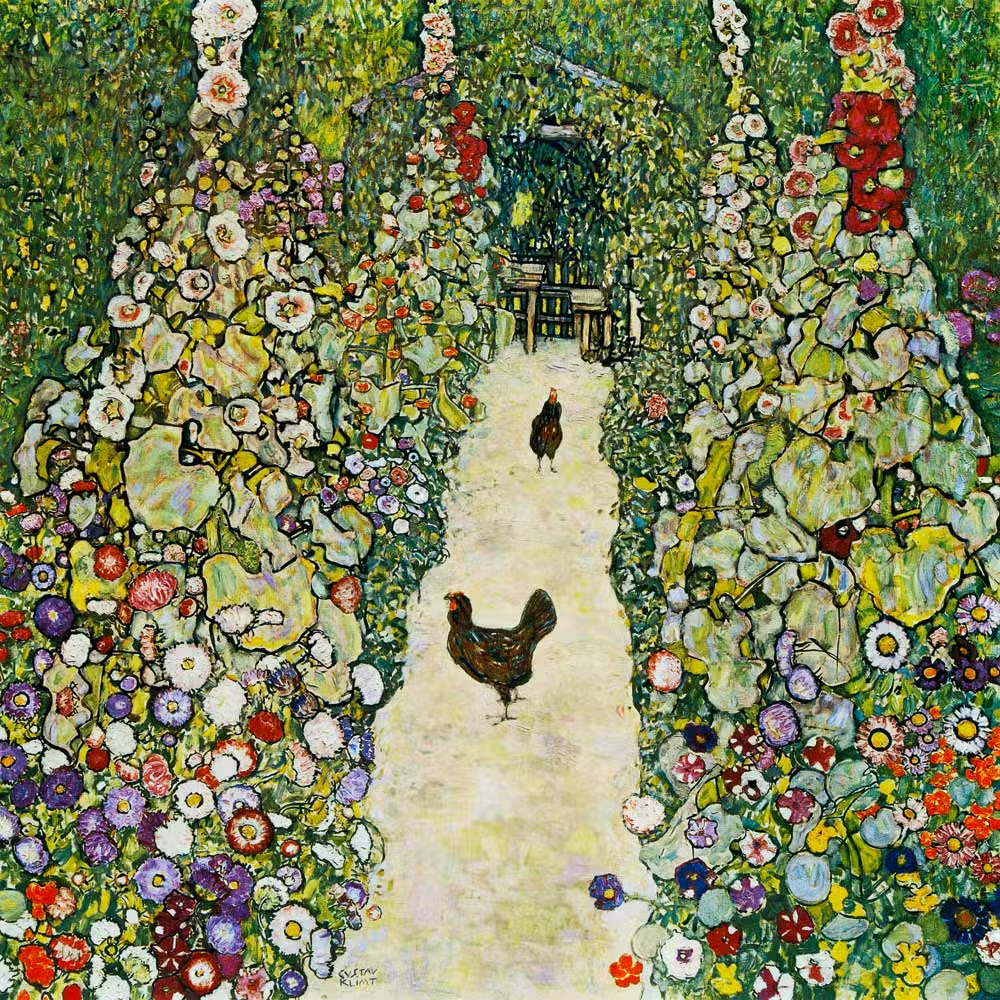
92- Garden Path with Chickens – Gustav Klimt
Garden Path with Chickens by Gustav Klimt, painted in 1916, is a charming and evocative landscape that captures the essence of rural life with Klimt’s distinctive artistic style. This painting reflects Klimt’s interest in integrating natural elements with his decorative approach.
In Garden Path with Chickens, Klimt portrays a picturesque garden path meandering through a lush, verdant setting, with chickens casually roaming along the way. The composition features Klimt’s characteristic use of rich colors and intricate patterns, blending realistic depictions of the garden and the chickens with decorative elements that add depth and visual interest.
The painting’s use of vibrant greens and earthy tones creates a sense of warmth and tranquility, while Klimt’s detailed brushwork and ornamental touches enhance the overall aesthetic. Garden Path with Chickens stands as a delightful example of Klimt’s ability to merge everyday scenes with his unique artistic vision, resulting in a work that is both charming and visually captivating.

93- Portrait of Maria Munk (Unfinished) – Gustav Klimt
Portrait of Maria Munk (Unfinished) by Gustav Klimt, painted around 1917, is an intriguing and emotionally resonant work that remains incomplete. This painting reflects Klimt’s distinctive approach to portraiture and his ability to convey profound psychological depth.
In Portrait of Maria Munk (Unfinished), Klimt presents the figure of Maria Munk, a young woman who was the daughter of a prominent Viennese family. The portrait captures Munk in a contemplative pose, with a focus on her face and upper body. Although the painting remains unfinished, Klimt’s attention to detail and the expressive quality of Munk’s expression are evident.
The background and surrounding elements are partially rendered, with Klimt’s characteristic decorative style emerging in the early stages of the composition. The use of color and texture creates a sense of depth and intimacy, while the incomplete nature of the work adds an element of mystery and poignancy. Portrait of Maria Munk (Unfinished) stands as a testament to Klimt’s ability to convey emotional and psychological nuances, even within an incomplete piece.

94- Portrait of Helene – Gustav Klimt
Portrait of Helene by Gustav Klimt, painted in 1898, is a striking portrait that captures the elegance and poise of its subject, Helene Klimt, the artist’s sister. This early work highlights Klimt’s skill in blending realistic portrayal with his emerging decorative style.
In Portrait of Helene, Klimt presents his sister Helene in a dignified and graceful manner. She is depicted with a detailed and realistic approach, dressed in a fashionable gown that reflects the fashion of the time. The background of the portrait features Klimt’s early use of ornamental patterns and textures, which enhance the overall composition and add a layer of visual interest.
The painting’s color palette and intricate detailing emphasize Helene’s refined presence and the artist’s meticulous attention to detail. Portrait of Helene stands as a significant example of Klimt’s early portrait work, showcasing his ability to capture personal elegance while beginning to explore his distinctive artistic style.
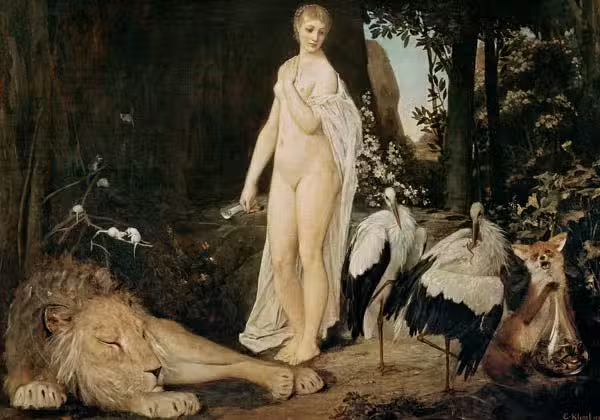
95- Fable – Gustav Klimt
Fable by Gustav Klimt, painted in 1908, is a captivating and enigmatic work that showcases Klimt’s exploration of symbolic and allegorical themes. This painting reflects his interest in integrating mythological and fantastical elements with his unique decorative style.
In Fable, Klimt presents a dreamlike scene filled with fantastical elements and symbolic imagery. The composition features a richly detailed and ornate background, with figures that embody mythical and allegorical themes. Klimt’s use of vibrant colors, intricate patterns, and textures adds depth and complexity to the painting, creating a visually engaging and thought-provoking work.
The painting’s symbolic content invites interpretation, with its combination of realistic detail and imaginative elements reflecting Klimt’s ability to blend the fantastical with the tangible. Fable stands as a testament to Klimt’s skill in creating works that are both visually stunning and rich in thematic depth, showcasing his innovative approach to art and storytelling.
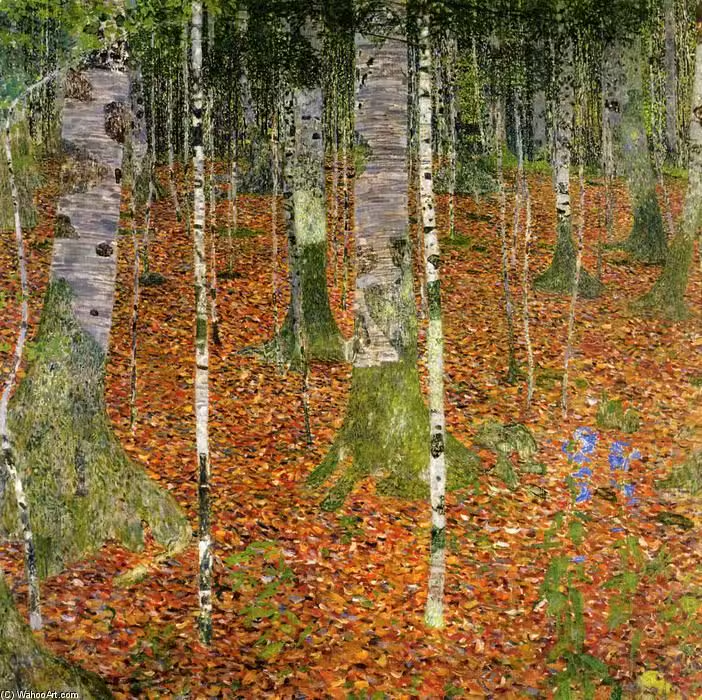
96- Farm with Birch Trees – Gustav Klimt
Farm with Birch Trees by Gustav Klimt, painted in 1903, is a serene and evocative landscape that reflects Klimt’s interest in capturing the beauty of rural settings through his distinctive artistic lens.
In Farm with Birch Trees, Klimt depicts a picturesque farm scene with a focus on the graceful birch trees that frame the composition. The painting features a harmonious blend of natural elements, with the birch trees standing out against a backdrop of rolling fields and a quaint farmhouse. Klimt’s use of color and brushwork creates a sense of tranquility and captures the essence of rural life.
The painting’s detailed rendering of the birch trees and the surrounding landscape highlights Klimt’s attention to natural beauty and his ability to infuse his landscapes with a sense of depth and atmosphere. Farm with Birch Trees stands as an example of Klimt’s ability to merge realistic depiction with his unique decorative style, resulting in a work that is both visually appealing and evocative of the serene beauty of the countryside.
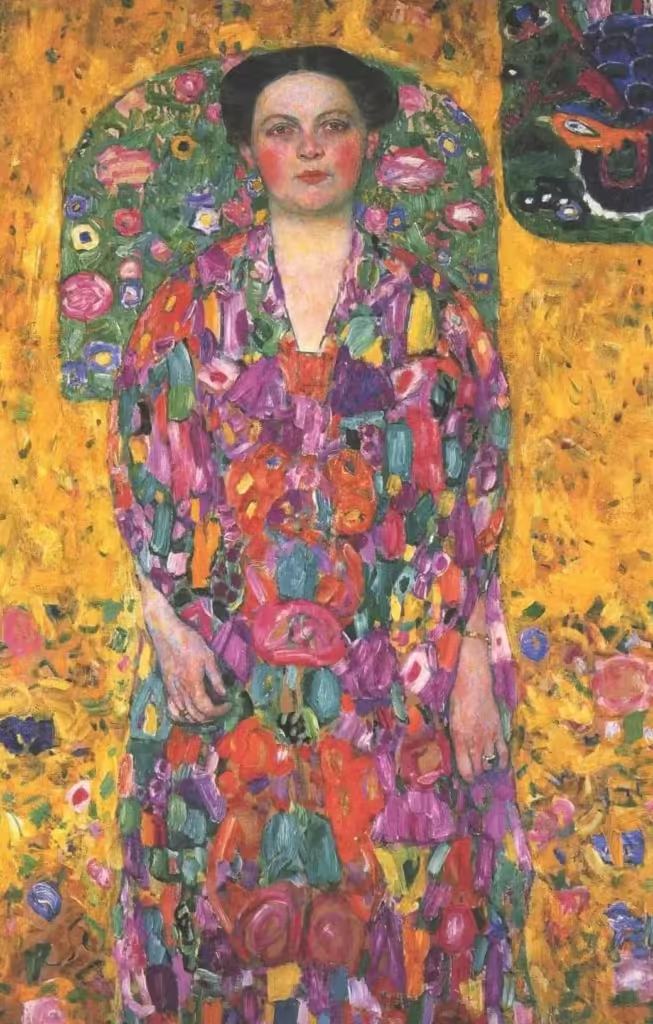
97- Eugenia Primavesi – Gustav Klimt
Eugenia Primavesi by Gustav Klimt, painted in 1913, is a captivating portrait that showcases Klimt’s distinctive approach to capturing the elegance and personality of his subjects. This painting is part of Klimt’s series of portraits of prominent Viennese figures and reflects his skill in blending realism with decorative elements.
In Eugenia Primavesi, Klimt portrays Eugenia Primavesi, a well-known socialite and philanthropist. She is depicted in an elegant and poised manner, adorned in a stylish gown that features intricate patterns and textures. The background of the portrait incorporates Klimt’s signature ornamental motifs, adding a layer of visual interest and enhancing the overall composition.
The painting’s use of rich colors and detailed textures highlights Primavesi’s sophistication and the intimate connection between the artist and his subject. Eugenia Primavesi stands as a testament to Klimt’s ability to blend personal elegance with his unique artistic style, resulting in a portrait that is both visually striking and reflective of his innovative approach to portraiture.

98- Field of Poppies – Gustav Klimt
Field of Poppies by Gustav Klimt, painted in 1907, is a vibrant and evocative landscape that captures the beauty of nature through Klimt’s distinctive style. This painting reflects Klimt’s interest in exploring the interplay between natural elements and decorative art.
In Field of Poppies, Klimt depicts a lush, flower-filled landscape dominated by a sea of poppies. The painting features a rich, colorful palette that emphasizes the vivid reds and greens of the poppy flowers, creating a dynamic and visually stimulating scene. Klimt’s characteristic use of intricate patterns and textures is evident in the detailed rendering of the flowers and the surrounding landscape.
The composition’s emphasis on the vibrant blooms and the serene backdrop highlights Klimt’s ability to blend realistic depiction with ornamental beauty. Field of Poppies stands as a testament to Klimt’s skill in capturing the essence of natural beauty while infusing it with his unique artistic touch, resulting in a work that is both lively and visually captivating.

99- Portrait of Marie Breunig – Gustav Klimt
Portrait of Marie Breunig by Gustav Klimt, painted in 1899, is a refined and elegant work that captures the grace and poise of its subject, Marie Breunig. This early portrait reflects Klimt’s evolving style and his keen interest in the interplay between realism and decorative elements.
In Portrait of Marie Breunig, Klimt portrays Marie Breunig with a sophisticated and dignified presence. She is depicted in a graceful pose, dressed in an opulent gown that features detailed patterns and textures. The background incorporates Klimt’s early use of ornamental motifs, which complement the subject and enhance the overall composition.
The painting’s color palette and intricate detailing highlight Breunig’s elegance and Klimt’s meticulous attention to the nuances of his subject. Portrait of Marie Breunig stands as a significant example of Klimt’s ability to blend realistic portraiture with his distinctive decorative style, resulting in a work that is both visually striking and reflective of his innovative artistic approach.

100- Portrait of Baroness Elisabeth Bachofen-Echt – Gustav Klimt
Portrait of Baroness Elisabeth Bachofen-Echt by Gustav Klimt, painted in 1917, is an exquisite and refined portrait that captures the elegance and stature of its subject. This painting exemplifies Klimt’s mature style, blending realistic portraiture with intricate decorative elements.
In Portrait of Baroness Elisabeth Bachofen-Echt, Klimt depicts the baroness in a dignified and graceful manner. She is shown in a luxurious gown, adorned with elaborate patterns that highlight Klimt’s signature decorative style. The background features a rich tapestry of ornamental motifs, adding depth and sophistication to the portrait.
The painting’s use of color and texture emphasizes the baroness’s elegance and the artist’s meticulous attention to detail. Klimt’s ability to merge realism with decorative art creates a striking and harmonious composition. Portrait of Baroness Elisabeth Bachofen-Echt stands as a testament to Klimt’s skill in capturing the essence of his subjects while showcasing his unique artistic vision.

Bonus 1 – Sappho – Gustav Klimt
Sappho by Gustav Klimt, painted in 1904, is a captivating and enigmatic work that explores themes of femininity and classical beauty through Klimt’s distinctive artistic style. This painting reflects Klimt’s fascination with mythology and his innovative approach to portraiture.
In Sappho, Klimt depicts the figure of Sappho, the ancient Greek poetess known for her lyrical poetry and association with love and beauty. The painting portrays Sappho in a thoughtful and introspective pose, surrounded by Klimt’s characteristic ornamental patterns and textures. Her presence is both regal and contemplative, capturing the essence of her legendary status.
The use of rich colors and intricate details in the background enhances the overall composition, adding a layer of visual complexity and depth. Klimt’s integration of decorative elements with the realistic portrayal of Sappho creates a striking contrast, emphasizing both the timelessness of the subject and the artist’s unique vision. Sappho stands as a testament to Klimt’s ability to blend mythological themes with his distinctive artistic approach, resulting in a work that is both visually captivating and deeply evocative.

Bonus 2 – Portrait of Marie Hen Mountain – Gustav Klimt
Portrait of Marie Hen Mountain by Gustav Klimt, painted in 1911, is a distinguished portrait that showcases Klimt’s skill in capturing the elegance and individuality of his subjects. This painting reflects Klimt’s mature style, blending realistic representation with his characteristic decorative elements.
In Portrait of Marie Hen Mountain, Klimt presents Marie Hen Mountain with an air of sophistication and grace. She is depicted in an elegant pose, adorned in a stylish gown that features intricate patterns and textures. The background of the portrait includes Klimt’s signature ornamental motifs, which enhance the overall composition and add a layer of visual interest.
The use of color and detail in the painting highlights Marie Hen Mountain’s refined presence and the artist’s meticulous attention to capturing her essence. Portrait of Marie Hen Mountain stands as a testament to Klimt’s ability to merge realistic portraiture with his unique decorative style, resulting in a work that is both striking and reflective of his innovative artistic approach.

Bonus 3 – Portrait of Emilie Flöge – Gustav Klimt
Portrait of Emilie Flöge by Gustav Klimt, painted in 1902, is a notable and intimate portrayal of one of Klimt’s closest companions and muse, Emilie Flöge. This painting reflects Klimt’s ability to capture both the elegance of his subject and his distinctive decorative style.
In Portrait of Emilie Flöge, Klimt presents Flöge in a graceful and dignified manner. She is depicted wearing an elaborate gown with intricate patterns that highlight Klimt’s skill in combining realistic representation with ornamental detail. The background features Klimt’s characteristic use of decorative elements, which enhance the visual richness of the portrait.
The painting’s use of color, texture, and pattern emphasizes Flöge’s refined beauty and the deep personal connection between the artist and his subject. Portrait of Emilie Flöge stands as a testament to Klimt’s ability to blend personal elegance with his innovative artistic approach, creating a work that is both visually captivating and deeply meaningful.
Conclusion: Top 100 Most Famous Paintings of Gustav Klimt
Gustav Klimt’s oeuvre is a testament to his extraordinary talent and unique vision. From his early works to his later masterpieces, Klimt’s paintings are characterized by their intricate detail, vibrant color palettes, and innovative use of decorative elements. The Top 100 Most Famous Paintings of Gustav Klimt offer a comprehensive glimpse into the evolution of his style and the profound impact of his artistic contributions.
Klimt’s portraits, such as The Kiss and Portrait of Adele Bloch-Bauer I, capture the elegance and depth of his subjects while blending realism with ornate, symbolic motifs. His landscapes, including The Tree of Life and Field of Poppies, showcase his ability to infuse natural scenes with a sense of beauty and transcendence.
Through his exploration of mythological themes, allegorical representations, and intimate portraits, Klimt has left an indelible mark on the world of art. The diversity and richness of his work reflect his mastery of technique and his innovative approach to combining art with symbolism and decoration.
The enduring appeal of Klimt’s paintings continues to captivate audiences, demonstrating the timeless nature of his artistic vision. As we reflect on these top 100 masterpieces, we gain a deeper appreciation for Klimt’s unique contributions to the art world and his ability to evoke emotion and beauty through his unparalleled artistry.
Leave a Reply